Care of the Older Person Assignment Sample
VerifiedAdded on 2021/06/14
|17
|5057
|1212
AI Summary
Contribute Materials
Your contribution can guide someone’s learning journey. Share your
documents today.
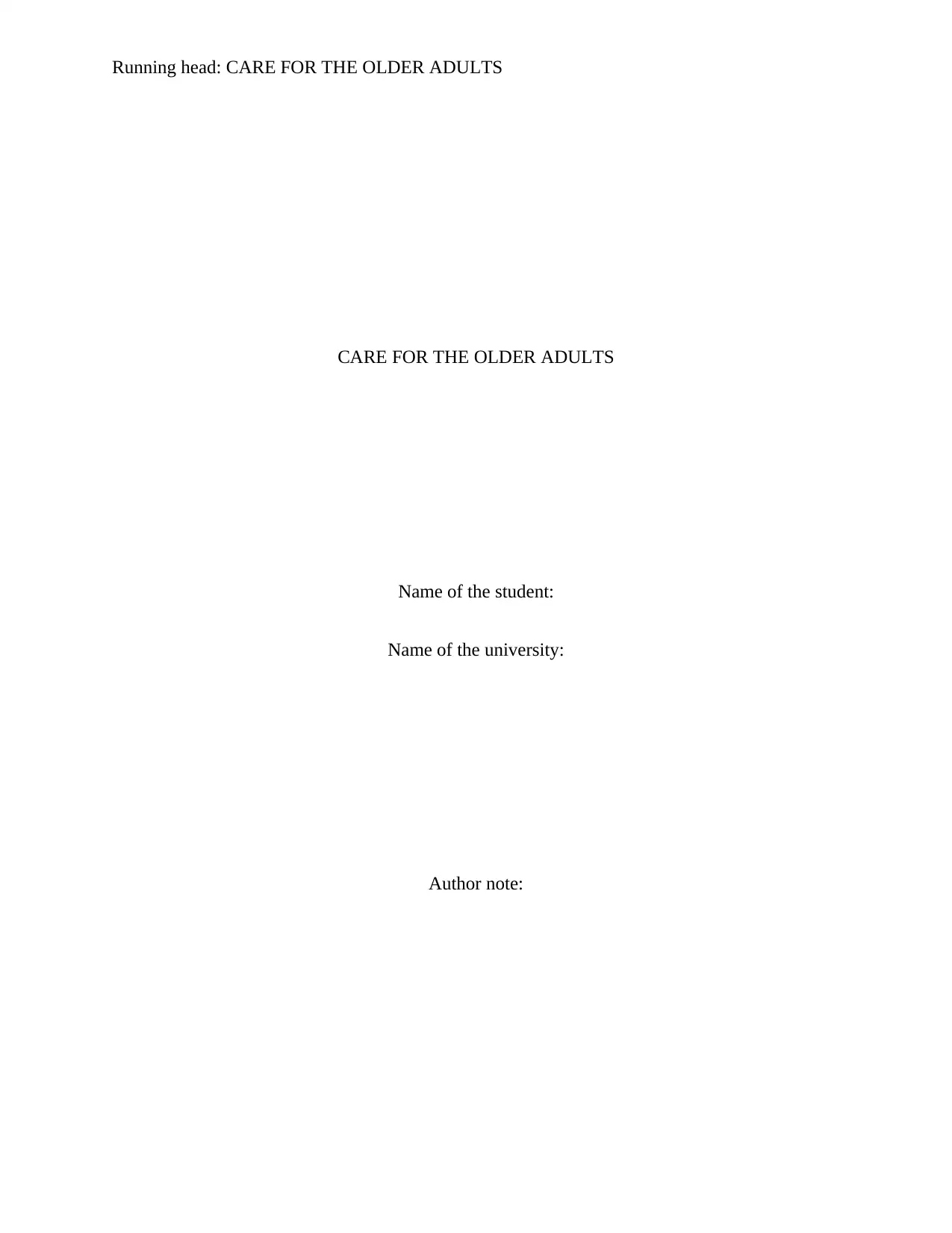
Running head: CARE FOR THE OLDER ADULTS
CARE FOR THE OLDER ADULTS
Name of the student:
Name of the university:
Author note:
CARE FOR THE OLDER ADULTS
Name of the student:
Name of the university:
Author note:
Secure Best Marks with AI Grader
Need help grading? Try our AI Grader for instant feedback on your assignments.
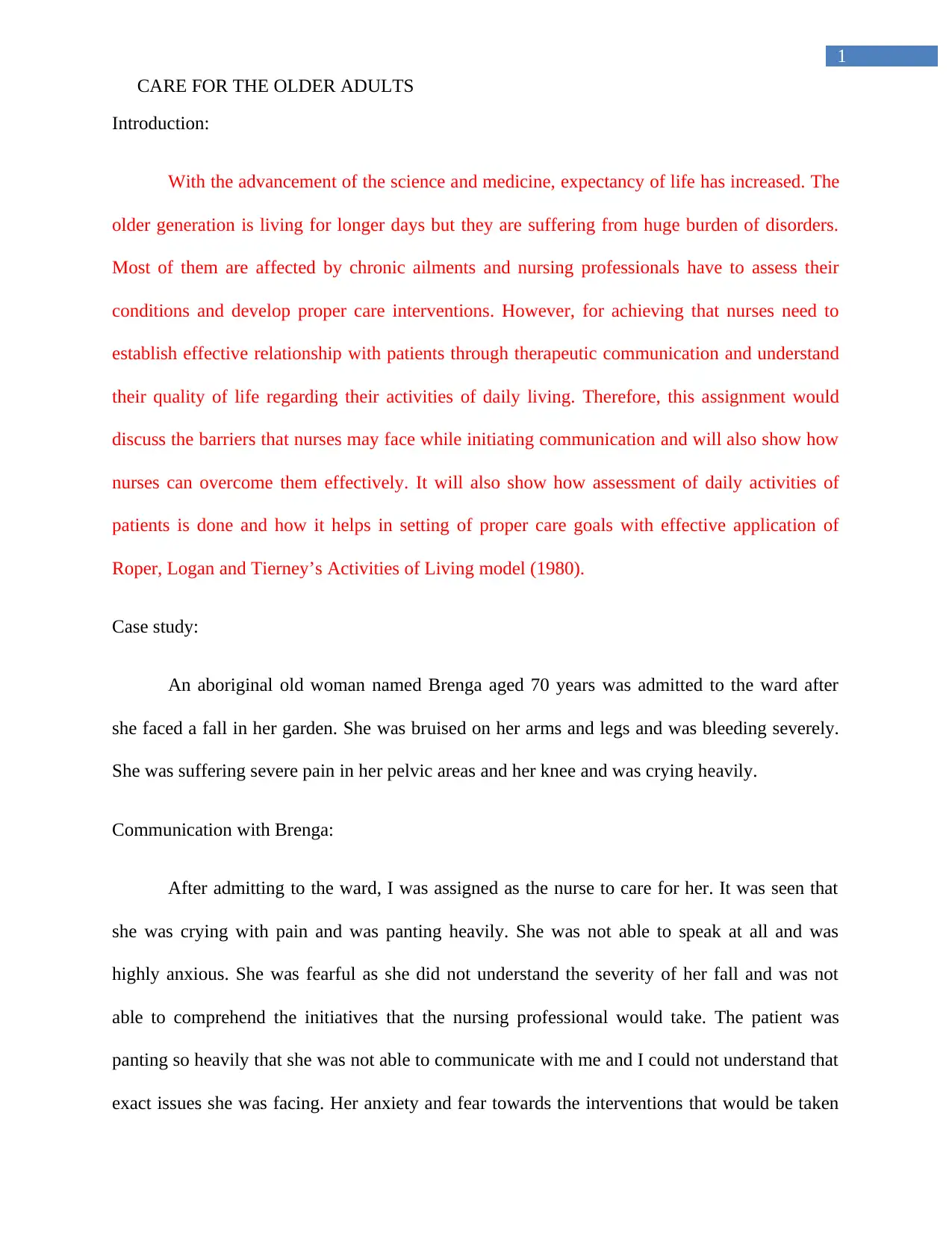
1
CARE FOR THE OLDER ADULTS
Introduction:
With the advancement of the science and medicine, expectancy of life has increased. The
older generation is living for longer days but they are suffering from huge burden of disorders.
Most of them are affected by chronic ailments and nursing professionals have to assess their
conditions and develop proper care interventions. However, for achieving that nurses need to
establish effective relationship with patients through therapeutic communication and understand
their quality of life regarding their activities of daily living. Therefore, this assignment would
discuss the barriers that nurses may face while initiating communication and will also show how
nurses can overcome them effectively. It will also show how assessment of daily activities of
patients is done and how it helps in setting of proper care goals with effective application of
Roper, Logan and Tierney’s Activities of Living model (1980).
Case study:
An aboriginal old woman named Brenga aged 70 years was admitted to the ward after
she faced a fall in her garden. She was bruised on her arms and legs and was bleeding severely.
She was suffering severe pain in her pelvic areas and her knee and was crying heavily.
Communication with Brenga:
After admitting to the ward, I was assigned as the nurse to care for her. It was seen that
she was crying with pain and was panting heavily. She was not able to speak at all and was
highly anxious. She was fearful as she did not understand the severity of her fall and was not
able to comprehend the initiatives that the nursing professional would take. The patient was
panting so heavily that she was not able to communicate with me and I could not understand that
exact issues she was facing. Her anxiety and fear towards the interventions that would be taken
CARE FOR THE OLDER ADULTS
Introduction:
With the advancement of the science and medicine, expectancy of life has increased. The
older generation is living for longer days but they are suffering from huge burden of disorders.
Most of them are affected by chronic ailments and nursing professionals have to assess their
conditions and develop proper care interventions. However, for achieving that nurses need to
establish effective relationship with patients through therapeutic communication and understand
their quality of life regarding their activities of daily living. Therefore, this assignment would
discuss the barriers that nurses may face while initiating communication and will also show how
nurses can overcome them effectively. It will also show how assessment of daily activities of
patients is done and how it helps in setting of proper care goals with effective application of
Roper, Logan and Tierney’s Activities of Living model (1980).
Case study:
An aboriginal old woman named Brenga aged 70 years was admitted to the ward after
she faced a fall in her garden. She was bruised on her arms and legs and was bleeding severely.
She was suffering severe pain in her pelvic areas and her knee and was crying heavily.
Communication with Brenga:
After admitting to the ward, I was assigned as the nurse to care for her. It was seen that
she was crying with pain and was panting heavily. She was not able to speak at all and was
highly anxious. She was fearful as she did not understand the severity of her fall and was not
able to comprehend the initiatives that the nursing professional would take. The patient was
panting so heavily that she was not able to communicate with me and I could not understand that
exact issues she was facing. Her anxiety and fear towards the interventions that would be taken
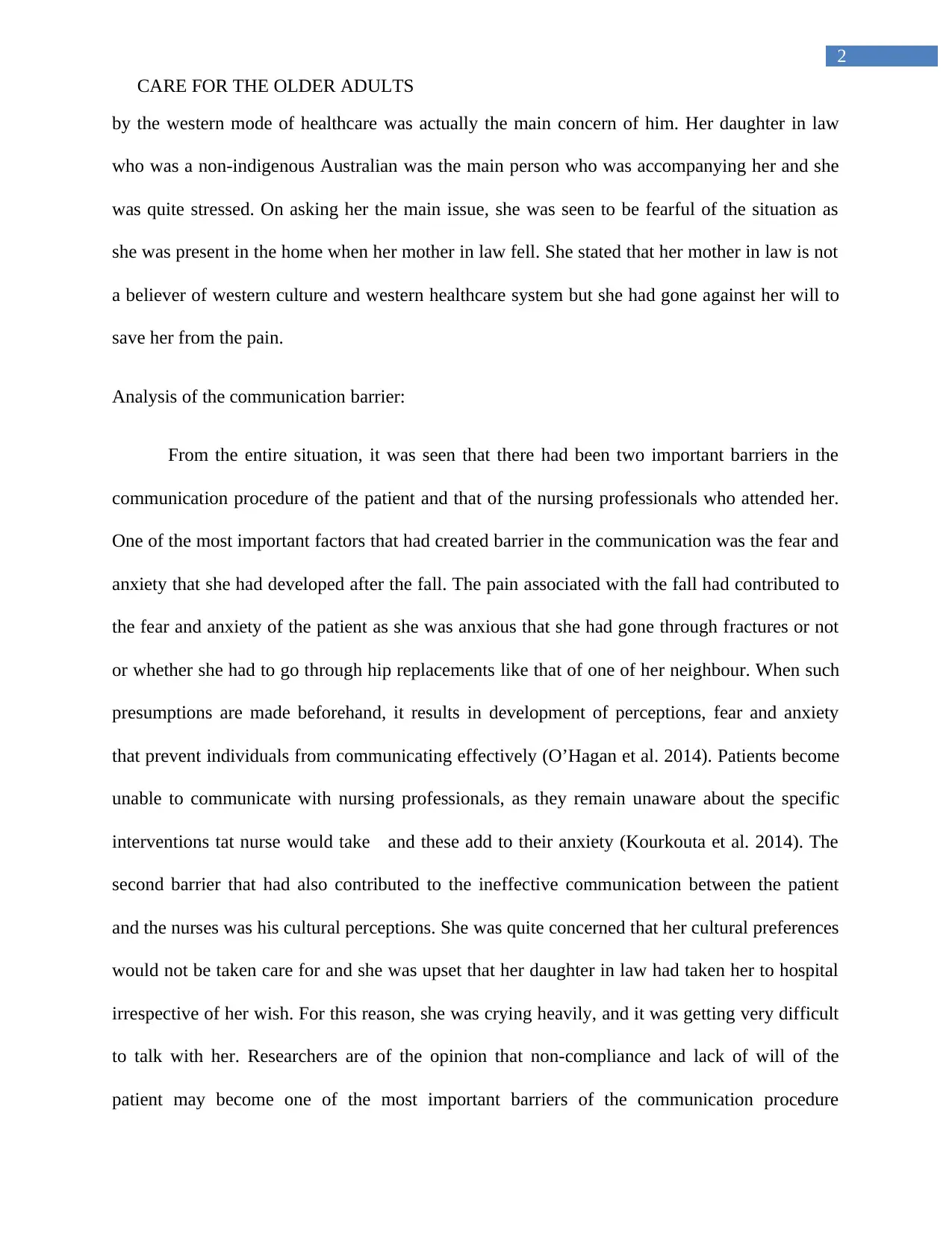
2
CARE FOR THE OLDER ADULTS
by the western mode of healthcare was actually the main concern of him. Her daughter in law
who was a non-indigenous Australian was the main person who was accompanying her and she
was quite stressed. On asking her the main issue, she was seen to be fearful of the situation as
she was present in the home when her mother in law fell. She stated that her mother in law is not
a believer of western culture and western healthcare system but she had gone against her will to
save her from the pain.
Analysis of the communication barrier:
From the entire situation, it was seen that there had been two important barriers in the
communication procedure of the patient and that of the nursing professionals who attended her.
One of the most important factors that had created barrier in the communication was the fear and
anxiety that she had developed after the fall. The pain associated with the fall had contributed to
the fear and anxiety of the patient as she was anxious that she had gone through fractures or not
or whether she had to go through hip replacements like that of one of her neighbour. When such
presumptions are made beforehand, it results in development of perceptions, fear and anxiety
that prevent individuals from communicating effectively (O’Hagan et al. 2014). Patients become
unable to communicate with nursing professionals, as they remain unaware about the specific
interventions tat nurse would take and these add to their anxiety (Kourkouta et al. 2014). The
second barrier that had also contributed to the ineffective communication between the patient
and the nurses was his cultural perceptions. She was quite concerned that her cultural preferences
would not be taken care for and she was upset that her daughter in law had taken her to hospital
irrespective of her wish. For this reason, she was crying heavily, and it was getting very difficult
to talk with her. Researchers are of the opinion that non-compliance and lack of will of the
patient may become one of the most important barriers of the communication procedure
CARE FOR THE OLDER ADULTS
by the western mode of healthcare was actually the main concern of him. Her daughter in law
who was a non-indigenous Australian was the main person who was accompanying her and she
was quite stressed. On asking her the main issue, she was seen to be fearful of the situation as
she was present in the home when her mother in law fell. She stated that her mother in law is not
a believer of western culture and western healthcare system but she had gone against her will to
save her from the pain.
Analysis of the communication barrier:
From the entire situation, it was seen that there had been two important barriers in the
communication procedure of the patient and that of the nursing professionals who attended her.
One of the most important factors that had created barrier in the communication was the fear and
anxiety that she had developed after the fall. The pain associated with the fall had contributed to
the fear and anxiety of the patient as she was anxious that she had gone through fractures or not
or whether she had to go through hip replacements like that of one of her neighbour. When such
presumptions are made beforehand, it results in development of perceptions, fear and anxiety
that prevent individuals from communicating effectively (O’Hagan et al. 2014). Patients become
unable to communicate with nursing professionals, as they remain unaware about the specific
interventions tat nurse would take and these add to their anxiety (Kourkouta et al. 2014). The
second barrier that had also contributed to the ineffective communication between the patient
and the nurses was his cultural perceptions. She was quite concerned that her cultural preferences
would not be taken care for and she was upset that her daughter in law had taken her to hospital
irrespective of her wish. For this reason, she was crying heavily, and it was getting very difficult
to talk with her. Researchers are of the opinion that non-compliance and lack of will of the
patient may become one of the most important barriers of the communication procedure
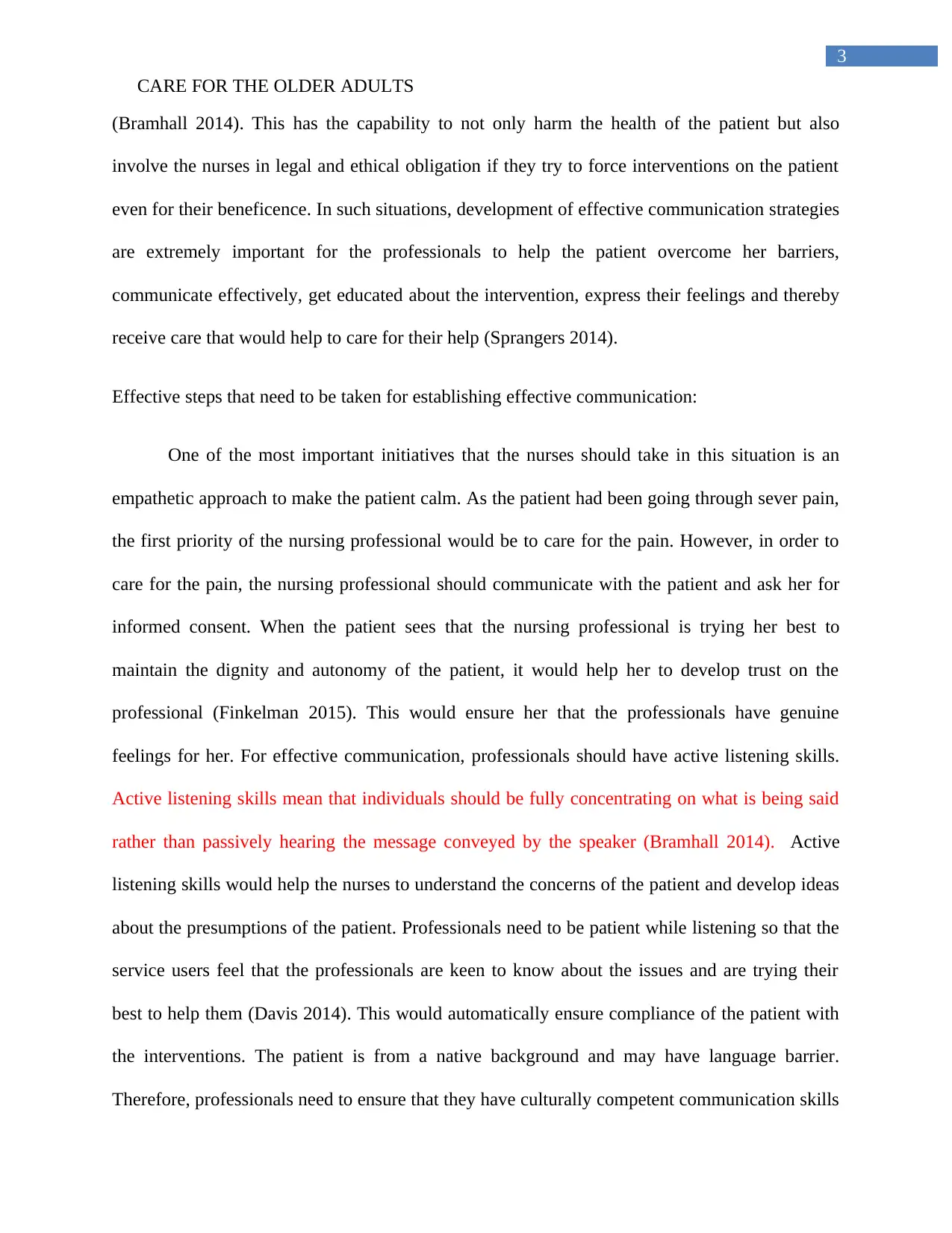
3
CARE FOR THE OLDER ADULTS
(Bramhall 2014). This has the capability to not only harm the health of the patient but also
involve the nurses in legal and ethical obligation if they try to force interventions on the patient
even for their beneficence. In such situations, development of effective communication strategies
are extremely important for the professionals to help the patient overcome her barriers,
communicate effectively, get educated about the intervention, express their feelings and thereby
receive care that would help to care for their help (Sprangers 2014).
Effective steps that need to be taken for establishing effective communication:
One of the most important initiatives that the nurses should take in this situation is an
empathetic approach to make the patient calm. As the patient had been going through sever pain,
the first priority of the nursing professional would be to care for the pain. However, in order to
care for the pain, the nursing professional should communicate with the patient and ask her for
informed consent. When the patient sees that the nursing professional is trying her best to
maintain the dignity and autonomy of the patient, it would help her to develop trust on the
professional (Finkelman 2015). This would ensure her that the professionals have genuine
feelings for her. For effective communication, professionals should have active listening skills.
Active listening skills mean that individuals should be fully concentrating on what is being said
rather than passively hearing the message conveyed by the speaker (Bramhall 2014). Active
listening skills would help the nurses to understand the concerns of the patient and develop ideas
about the presumptions of the patient. Professionals need to be patient while listening so that the
service users feel that the professionals are keen to know about the issues and are trying their
best to help them (Davis 2014). This would automatically ensure compliance of the patient with
the interventions. The patient is from a native background and may have language barrier.
Therefore, professionals need to ensure that they have culturally competent communication skills
CARE FOR THE OLDER ADULTS
(Bramhall 2014). This has the capability to not only harm the health of the patient but also
involve the nurses in legal and ethical obligation if they try to force interventions on the patient
even for their beneficence. In such situations, development of effective communication strategies
are extremely important for the professionals to help the patient overcome her barriers,
communicate effectively, get educated about the intervention, express their feelings and thereby
receive care that would help to care for their help (Sprangers 2014).
Effective steps that need to be taken for establishing effective communication:
One of the most important initiatives that the nurses should take in this situation is an
empathetic approach to make the patient calm. As the patient had been going through sever pain,
the first priority of the nursing professional would be to care for the pain. However, in order to
care for the pain, the nursing professional should communicate with the patient and ask her for
informed consent. When the patient sees that the nursing professional is trying her best to
maintain the dignity and autonomy of the patient, it would help her to develop trust on the
professional (Finkelman 2015). This would ensure her that the professionals have genuine
feelings for her. For effective communication, professionals should have active listening skills.
Active listening skills mean that individuals should be fully concentrating on what is being said
rather than passively hearing the message conveyed by the speaker (Bramhall 2014). Active
listening skills would help the nurses to understand the concerns of the patient and develop ideas
about the presumptions of the patient. Professionals need to be patient while listening so that the
service users feel that the professionals are keen to know about the issues and are trying their
best to help them (Davis 2014). This would automatically ensure compliance of the patient with
the interventions. The patient is from a native background and may have language barrier.
Therefore, professionals need to ensure that they have culturally competent communication skills
Secure Best Marks with AI Grader
Need help grading? Try our AI Grader for instant feedback on your assignments.
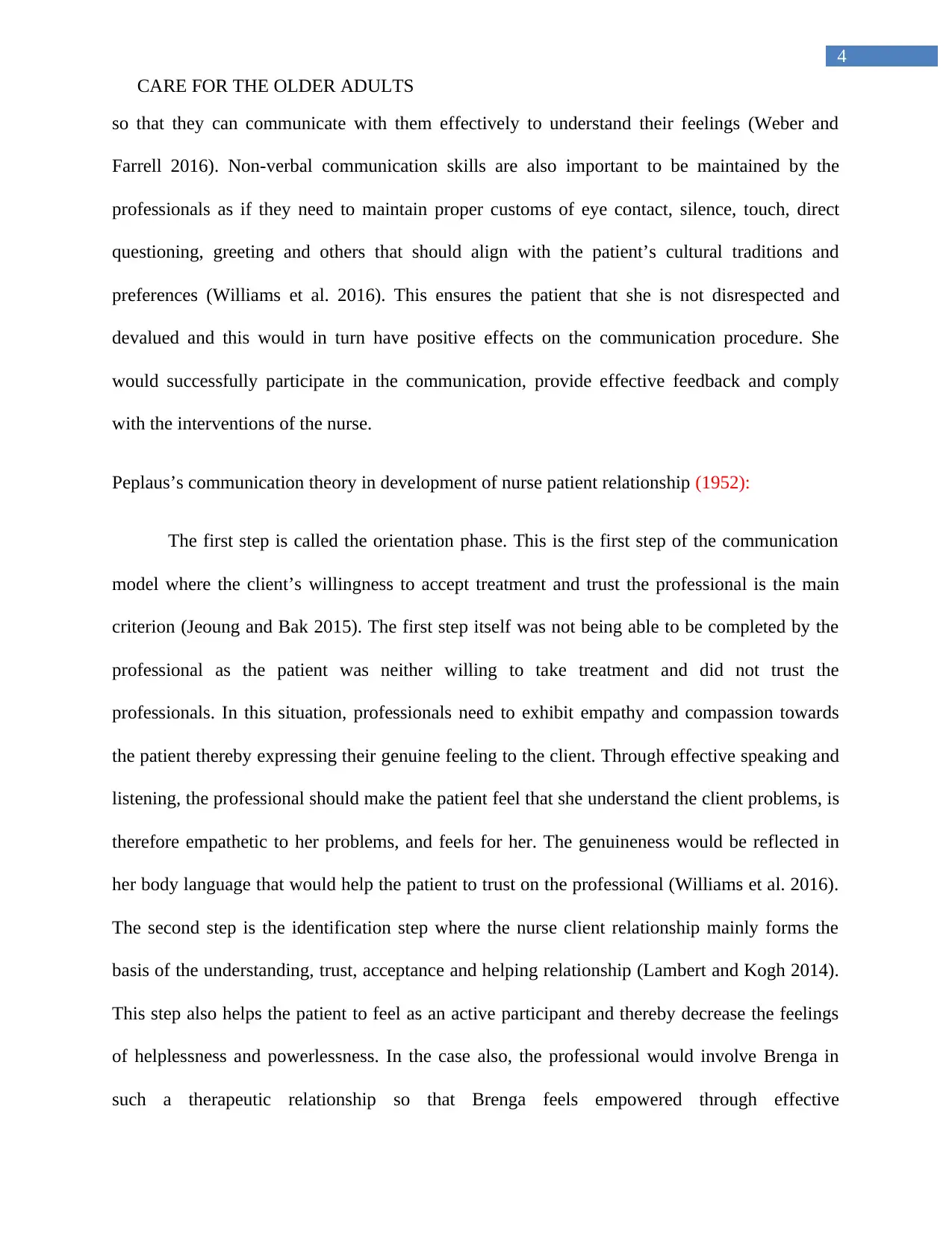
4
CARE FOR THE OLDER ADULTS
so that they can communicate with them effectively to understand their feelings (Weber and
Farrell 2016). Non-verbal communication skills are also important to be maintained by the
professionals as if they need to maintain proper customs of eye contact, silence, touch, direct
questioning, greeting and others that should align with the patient’s cultural traditions and
preferences (Williams et al. 2016). This ensures the patient that she is not disrespected and
devalued and this would in turn have positive effects on the communication procedure. She
would successfully participate in the communication, provide effective feedback and comply
with the interventions of the nurse.
Peplaus’s communication theory in development of nurse patient relationship (1952):
The first step is called the orientation phase. This is the first step of the communication
model where the client’s willingness to accept treatment and trust the professional is the main
criterion (Jeoung and Bak 2015). The first step itself was not being able to be completed by the
professional as the patient was neither willing to take treatment and did not trust the
professionals. In this situation, professionals need to exhibit empathy and compassion towards
the patient thereby expressing their genuine feeling to the client. Through effective speaking and
listening, the professional should make the patient feel that she understand the client problems, is
therefore empathetic to her problems, and feels for her. The genuineness would be reflected in
her body language that would help the patient to trust on the professional (Williams et al. 2016).
The second step is the identification step where the nurse client relationship mainly forms the
basis of the understanding, trust, acceptance and helping relationship (Lambert and Kogh 2014).
This step also helps the patient to feel as an active participant and thereby decrease the feelings
of helplessness and powerlessness. In the case also, the professional would involve Brenga in
such a therapeutic relationship so that Brenga feels empowered through effective
CARE FOR THE OLDER ADULTS
so that they can communicate with them effectively to understand their feelings (Weber and
Farrell 2016). Non-verbal communication skills are also important to be maintained by the
professionals as if they need to maintain proper customs of eye contact, silence, touch, direct
questioning, greeting and others that should align with the patient’s cultural traditions and
preferences (Williams et al. 2016). This ensures the patient that she is not disrespected and
devalued and this would in turn have positive effects on the communication procedure. She
would successfully participate in the communication, provide effective feedback and comply
with the interventions of the nurse.
Peplaus’s communication theory in development of nurse patient relationship (1952):
The first step is called the orientation phase. This is the first step of the communication
model where the client’s willingness to accept treatment and trust the professional is the main
criterion (Jeoung and Bak 2015). The first step itself was not being able to be completed by the
professional as the patient was neither willing to take treatment and did not trust the
professionals. In this situation, professionals need to exhibit empathy and compassion towards
the patient thereby expressing their genuine feeling to the client. Through effective speaking and
listening, the professional should make the patient feel that she understand the client problems, is
therefore empathetic to her problems, and feels for her. The genuineness would be reflected in
her body language that would help the patient to trust on the professional (Williams et al. 2016).
The second step is the identification step where the nurse client relationship mainly forms the
basis of the understanding, trust, acceptance and helping relationship (Lambert and Kogh 2014).
This step also helps the patient to feel as an active participant and thereby decrease the feelings
of helplessness and powerlessness. In the case also, the professional would involve Brenga in
such a therapeutic relationship so that Brenga feels empowered through effective
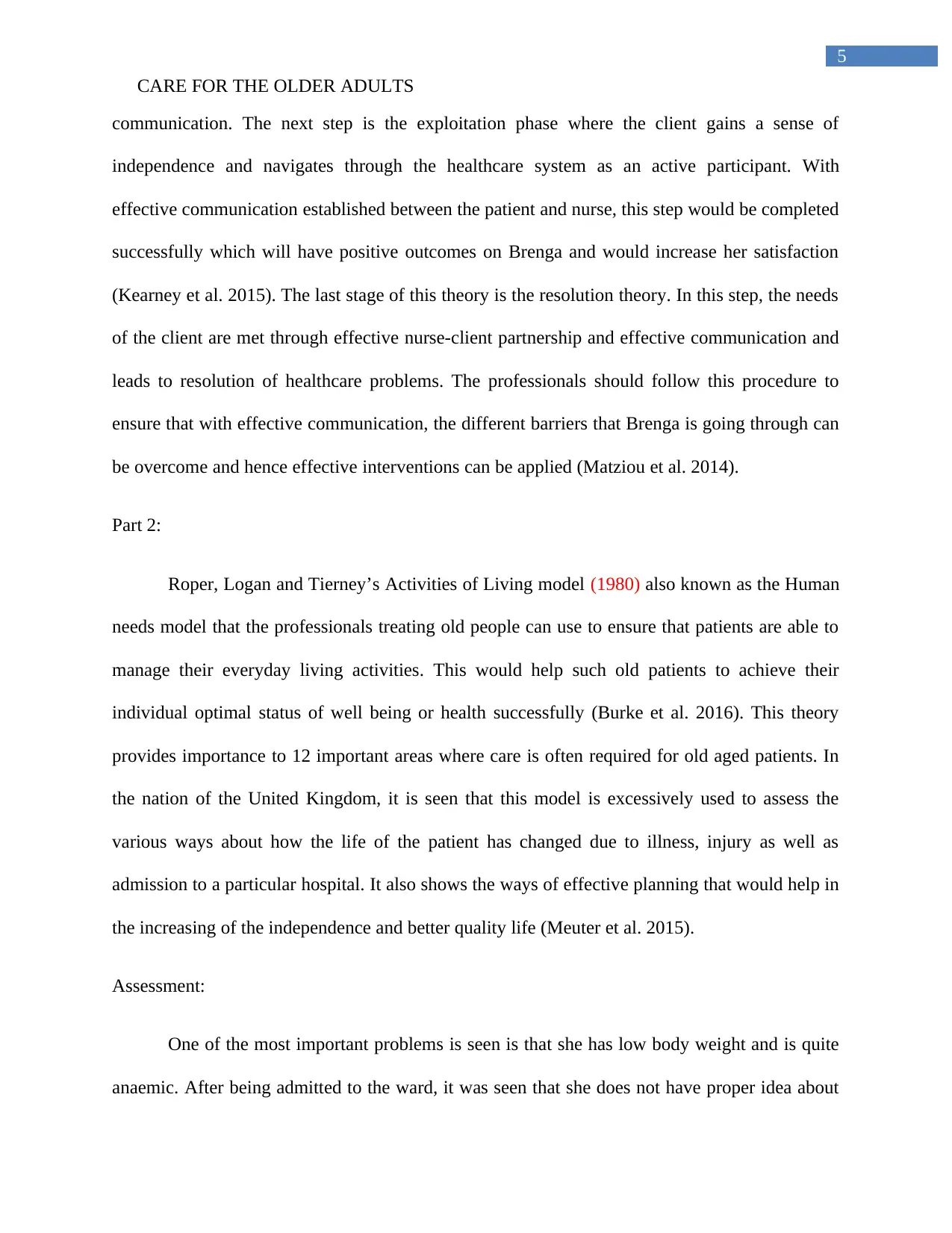
5
CARE FOR THE OLDER ADULTS
communication. The next step is the exploitation phase where the client gains a sense of
independence and navigates through the healthcare system as an active participant. With
effective communication established between the patient and nurse, this step would be completed
successfully which will have positive outcomes on Brenga and would increase her satisfaction
(Kearney et al. 2015). The last stage of this theory is the resolution theory. In this step, the needs
of the client are met through effective nurse-client partnership and effective communication and
leads to resolution of healthcare problems. The professionals should follow this procedure to
ensure that with effective communication, the different barriers that Brenga is going through can
be overcome and hence effective interventions can be applied (Matziou et al. 2014).
Part 2:
Roper, Logan and Tierney’s Activities of Living model (1980) also known as the Human
needs model that the professionals treating old people can use to ensure that patients are able to
manage their everyday living activities. This would help such old patients to achieve their
individual optimal status of well being or health successfully (Burke et al. 2016). This theory
provides importance to 12 important areas where care is often required for old aged patients. In
the nation of the United Kingdom, it is seen that this model is excessively used to assess the
various ways about how the life of the patient has changed due to illness, injury as well as
admission to a particular hospital. It also shows the ways of effective planning that would help in
the increasing of the independence and better quality life (Meuter et al. 2015).
Assessment:
One of the most important problems is seen is that she has low body weight and is quite
anaemic. After being admitted to the ward, it was seen that she does not have proper idea about
CARE FOR THE OLDER ADULTS
communication. The next step is the exploitation phase where the client gains a sense of
independence and navigates through the healthcare system as an active participant. With
effective communication established between the patient and nurse, this step would be completed
successfully which will have positive outcomes on Brenga and would increase her satisfaction
(Kearney et al. 2015). The last stage of this theory is the resolution theory. In this step, the needs
of the client are met through effective nurse-client partnership and effective communication and
leads to resolution of healthcare problems. The professionals should follow this procedure to
ensure that with effective communication, the different barriers that Brenga is going through can
be overcome and hence effective interventions can be applied (Matziou et al. 2014).
Part 2:
Roper, Logan and Tierney’s Activities of Living model (1980) also known as the Human
needs model that the professionals treating old people can use to ensure that patients are able to
manage their everyday living activities. This would help such old patients to achieve their
individual optimal status of well being or health successfully (Burke et al. 2016). This theory
provides importance to 12 important areas where care is often required for old aged patients. In
the nation of the United Kingdom, it is seen that this model is excessively used to assess the
various ways about how the life of the patient has changed due to illness, injury as well as
admission to a particular hospital. It also shows the ways of effective planning that would help in
the increasing of the independence and better quality life (Meuter et al. 2015).
Assessment:
One of the most important problems is seen is that she has low body weight and is quite
anaemic. After being admitted to the ward, it was seen that she does not have proper idea about
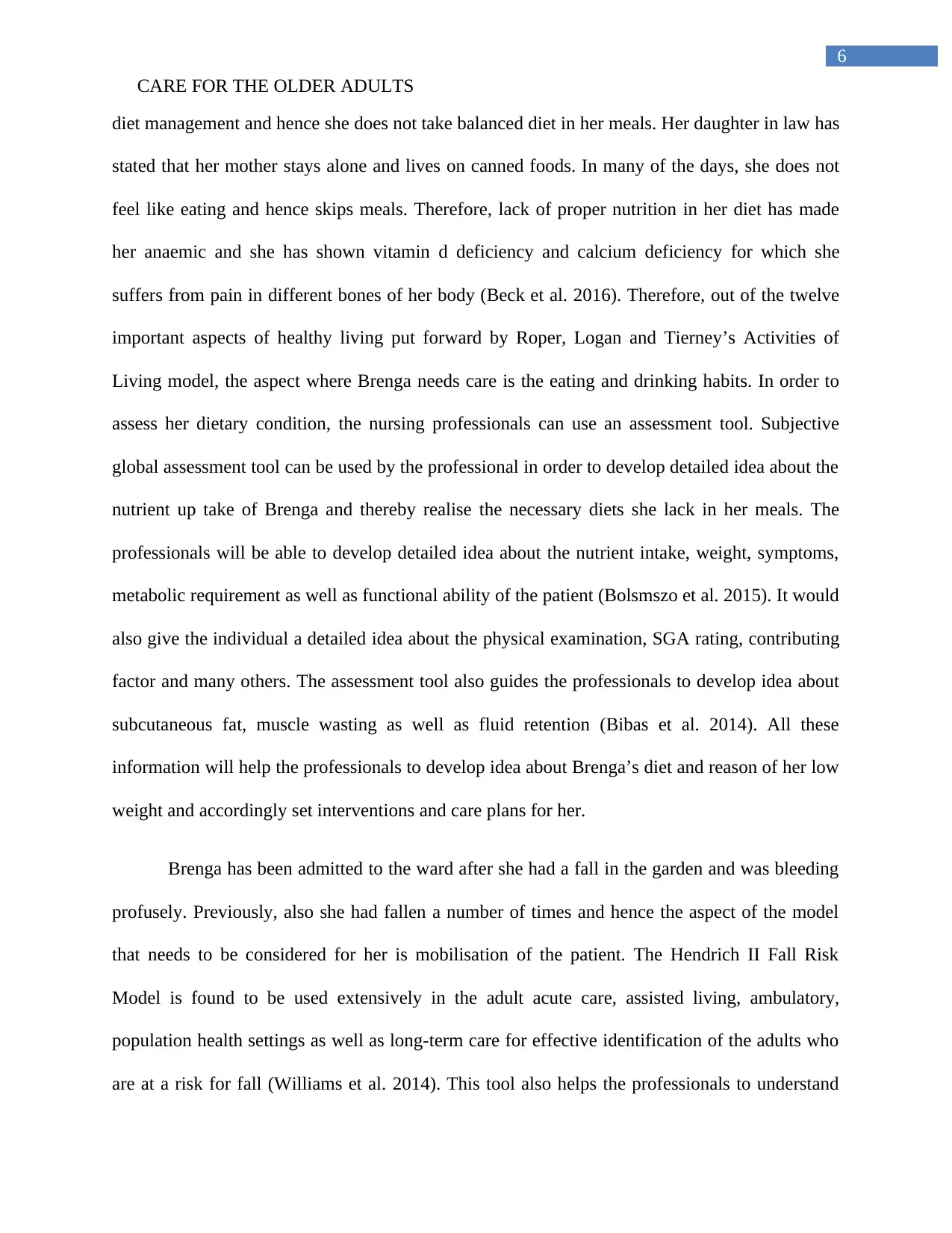
6
CARE FOR THE OLDER ADULTS
diet management and hence she does not take balanced diet in her meals. Her daughter in law has
stated that her mother stays alone and lives on canned foods. In many of the days, she does not
feel like eating and hence skips meals. Therefore, lack of proper nutrition in her diet has made
her anaemic and she has shown vitamin d deficiency and calcium deficiency for which she
suffers from pain in different bones of her body (Beck et al. 2016). Therefore, out of the twelve
important aspects of healthy living put forward by Roper, Logan and Tierney’s Activities of
Living model, the aspect where Brenga needs care is the eating and drinking habits. In order to
assess her dietary condition, the nursing professionals can use an assessment tool. Subjective
global assessment tool can be used by the professional in order to develop detailed idea about the
nutrient up take of Brenga and thereby realise the necessary diets she lack in her meals. The
professionals will be able to develop detailed idea about the nutrient intake, weight, symptoms,
metabolic requirement as well as functional ability of the patient (Bolsmszo et al. 2015). It would
also give the individual a detailed idea about the physical examination, SGA rating, contributing
factor and many others. The assessment tool also guides the professionals to develop idea about
subcutaneous fat, muscle wasting as well as fluid retention (Bibas et al. 2014). All these
information will help the professionals to develop idea about Brenga’s diet and reason of her low
weight and accordingly set interventions and care plans for her.
Brenga has been admitted to the ward after she had a fall in the garden and was bleeding
profusely. Previously, also she had fallen a number of times and hence the aspect of the model
that needs to be considered for her is mobilisation of the patient. The Hendrich II Fall Risk
Model is found to be used extensively in the adult acute care, assisted living, ambulatory,
population health settings as well as long-term care for effective identification of the adults who
are at a risk for fall (Williams et al. 2014). This tool also helps the professionals to understand
CARE FOR THE OLDER ADULTS
diet management and hence she does not take balanced diet in her meals. Her daughter in law has
stated that her mother stays alone and lives on canned foods. In many of the days, she does not
feel like eating and hence skips meals. Therefore, lack of proper nutrition in her diet has made
her anaemic and she has shown vitamin d deficiency and calcium deficiency for which she
suffers from pain in different bones of her body (Beck et al. 2016). Therefore, out of the twelve
important aspects of healthy living put forward by Roper, Logan and Tierney’s Activities of
Living model, the aspect where Brenga needs care is the eating and drinking habits. In order to
assess her dietary condition, the nursing professionals can use an assessment tool. Subjective
global assessment tool can be used by the professional in order to develop detailed idea about the
nutrient up take of Brenga and thereby realise the necessary diets she lack in her meals. The
professionals will be able to develop detailed idea about the nutrient intake, weight, symptoms,
metabolic requirement as well as functional ability of the patient (Bolsmszo et al. 2015). It would
also give the individual a detailed idea about the physical examination, SGA rating, contributing
factor and many others. The assessment tool also guides the professionals to develop idea about
subcutaneous fat, muscle wasting as well as fluid retention (Bibas et al. 2014). All these
information will help the professionals to develop idea about Brenga’s diet and reason of her low
weight and accordingly set interventions and care plans for her.
Brenga has been admitted to the ward after she had a fall in the garden and was bleeding
profusely. Previously, also she had fallen a number of times and hence the aspect of the model
that needs to be considered for her is mobilisation of the patient. The Hendrich II Fall Risk
Model is found to be used extensively in the adult acute care, assisted living, ambulatory,
population health settings as well as long-term care for effective identification of the adults who
are at a risk for fall (Williams et al. 2014). This tool also helps the professionals to understand
Paraphrase This Document
Need a fresh take? Get an instant paraphrase of this document with our AI Paraphraser
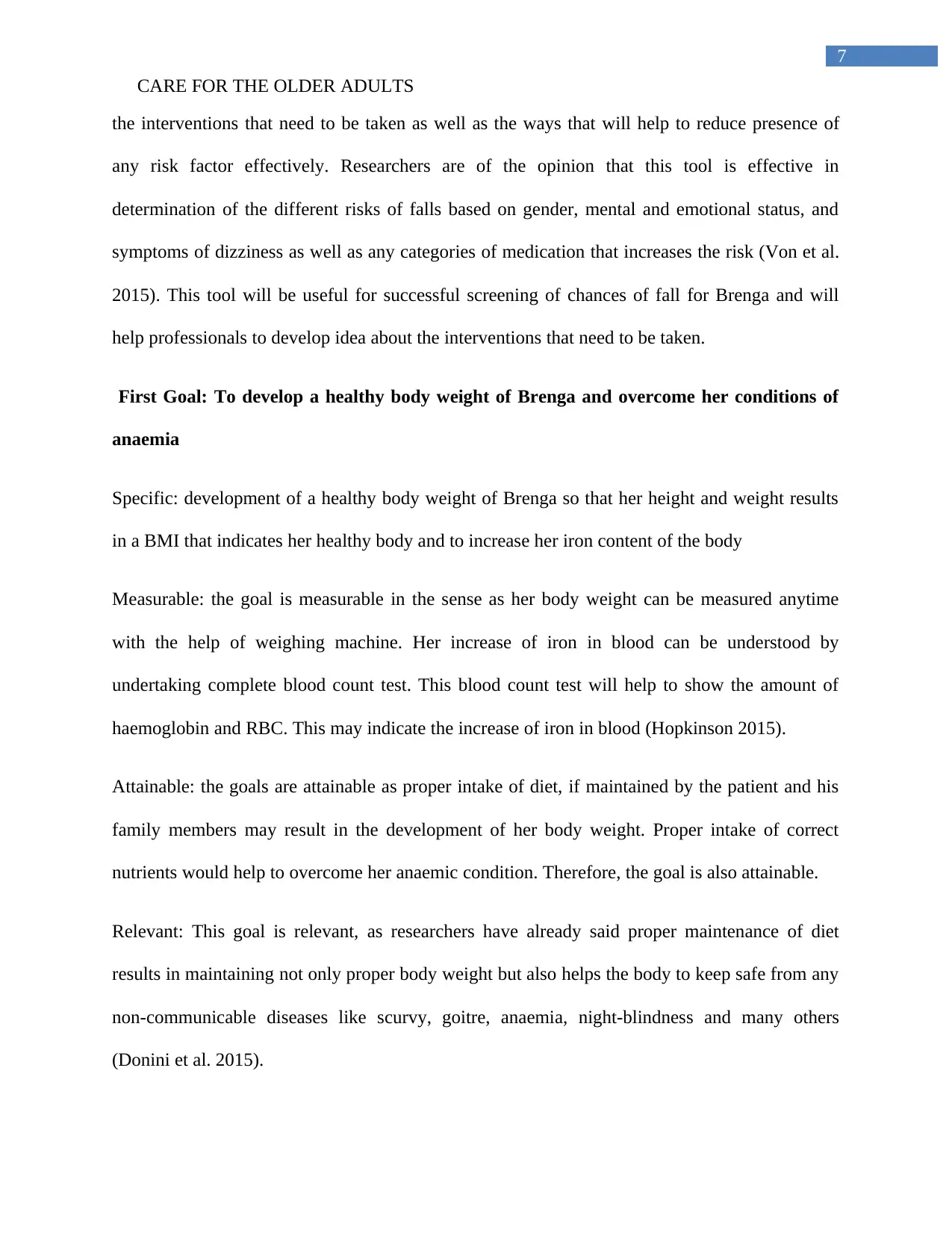
7
CARE FOR THE OLDER ADULTS
the interventions that need to be taken as well as the ways that will help to reduce presence of
any risk factor effectively. Researchers are of the opinion that this tool is effective in
determination of the different risks of falls based on gender, mental and emotional status, and
symptoms of dizziness as well as any categories of medication that increases the risk (Von et al.
2015). This tool will be useful for successful screening of chances of fall for Brenga and will
help professionals to develop idea about the interventions that need to be taken.
First Goal: To develop a healthy body weight of Brenga and overcome her conditions of
anaemia
Specific: development of a healthy body weight of Brenga so that her height and weight results
in a BMI that indicates her healthy body and to increase her iron content of the body
Measurable: the goal is measurable in the sense as her body weight can be measured anytime
with the help of weighing machine. Her increase of iron in blood can be understood by
undertaking complete blood count test. This blood count test will help to show the amount of
haemoglobin and RBC. This may indicate the increase of iron in blood (Hopkinson 2015).
Attainable: the goals are attainable as proper intake of diet, if maintained by the patient and his
family members may result in the development of her body weight. Proper intake of correct
nutrients would help to overcome her anaemic condition. Therefore, the goal is also attainable.
Relevant: This goal is relevant, as researchers have already said proper maintenance of diet
results in maintaining not only proper body weight but also helps the body to keep safe from any
non-communicable diseases like scurvy, goitre, anaemia, night-blindness and many others
(Donini et al. 2015).
CARE FOR THE OLDER ADULTS
the interventions that need to be taken as well as the ways that will help to reduce presence of
any risk factor effectively. Researchers are of the opinion that this tool is effective in
determination of the different risks of falls based on gender, mental and emotional status, and
symptoms of dizziness as well as any categories of medication that increases the risk (Von et al.
2015). This tool will be useful for successful screening of chances of fall for Brenga and will
help professionals to develop idea about the interventions that need to be taken.
First Goal: To develop a healthy body weight of Brenga and overcome her conditions of
anaemia
Specific: development of a healthy body weight of Brenga so that her height and weight results
in a BMI that indicates her healthy body and to increase her iron content of the body
Measurable: the goal is measurable in the sense as her body weight can be measured anytime
with the help of weighing machine. Her increase of iron in blood can be understood by
undertaking complete blood count test. This blood count test will help to show the amount of
haemoglobin and RBC. This may indicate the increase of iron in blood (Hopkinson 2015).
Attainable: the goals are attainable as proper intake of diet, if maintained by the patient and his
family members may result in the development of her body weight. Proper intake of correct
nutrients would help to overcome her anaemic condition. Therefore, the goal is also attainable.
Relevant: This goal is relevant, as researchers have already said proper maintenance of diet
results in maintaining not only proper body weight but also helps the body to keep safe from any
non-communicable diseases like scurvy, goitre, anaemia, night-blindness and many others
(Donini et al. 2015).
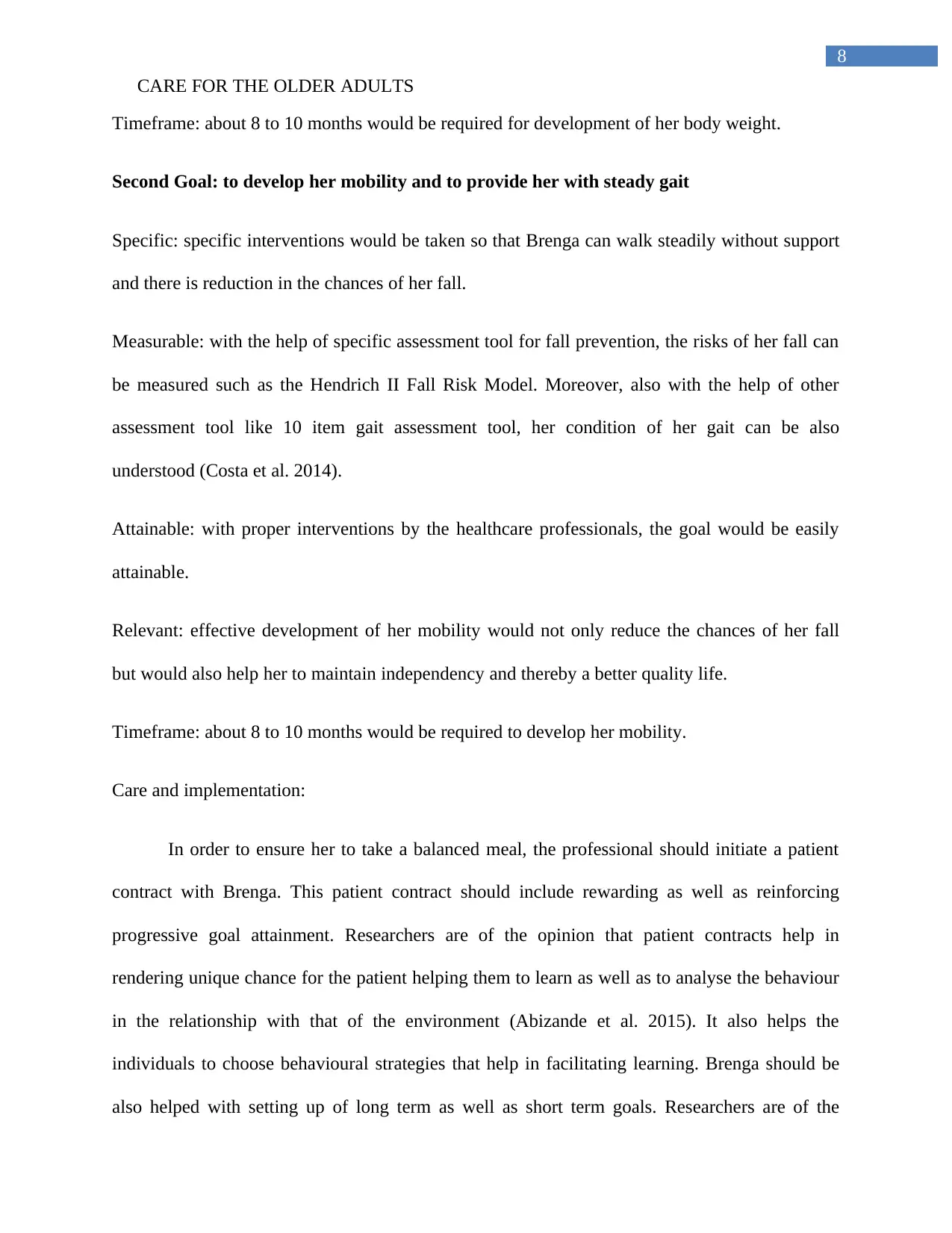
8
CARE FOR THE OLDER ADULTS
Timeframe: about 8 to 10 months would be required for development of her body weight.
Second Goal: to develop her mobility and to provide her with steady gait
Specific: specific interventions would be taken so that Brenga can walk steadily without support
and there is reduction in the chances of her fall.
Measurable: with the help of specific assessment tool for fall prevention, the risks of her fall can
be measured such as the Hendrich II Fall Risk Model. Moreover, also with the help of other
assessment tool like 10 item gait assessment tool, her condition of her gait can be also
understood (Costa et al. 2014).
Attainable: with proper interventions by the healthcare professionals, the goal would be easily
attainable.
Relevant: effective development of her mobility would not only reduce the chances of her fall
but would also help her to maintain independency and thereby a better quality life.
Timeframe: about 8 to 10 months would be required to develop her mobility.
Care and implementation:
In order to ensure her to take a balanced meal, the professional should initiate a patient
contract with Brenga. This patient contract should include rewarding as well as reinforcing
progressive goal attainment. Researchers are of the opinion that patient contracts help in
rendering unique chance for the patient helping them to learn as well as to analyse the behaviour
in the relationship with that of the environment (Abizande et al. 2015). It also helps the
individuals to choose behavioural strategies that help in facilitating learning. Brenga should be
also helped with setting up of long term as well as short term goals. Researchers are of the
CARE FOR THE OLDER ADULTS
Timeframe: about 8 to 10 months would be required for development of her body weight.
Second Goal: to develop her mobility and to provide her with steady gait
Specific: specific interventions would be taken so that Brenga can walk steadily without support
and there is reduction in the chances of her fall.
Measurable: with the help of specific assessment tool for fall prevention, the risks of her fall can
be measured such as the Hendrich II Fall Risk Model. Moreover, also with the help of other
assessment tool like 10 item gait assessment tool, her condition of her gait can be also
understood (Costa et al. 2014).
Attainable: with proper interventions by the healthcare professionals, the goal would be easily
attainable.
Relevant: effective development of her mobility would not only reduce the chances of her fall
but would also help her to maintain independency and thereby a better quality life.
Timeframe: about 8 to 10 months would be required to develop her mobility.
Care and implementation:
In order to ensure her to take a balanced meal, the professional should initiate a patient
contract with Brenga. This patient contract should include rewarding as well as reinforcing
progressive goal attainment. Researchers are of the opinion that patient contracts help in
rendering unique chance for the patient helping them to learn as well as to analyse the behaviour
in the relationship with that of the environment (Abizande et al. 2015). It also helps the
individuals to choose behavioural strategies that help in facilitating learning. Brenga should be
also helped with setting up of long term as well as short term goals. Researchers are of the
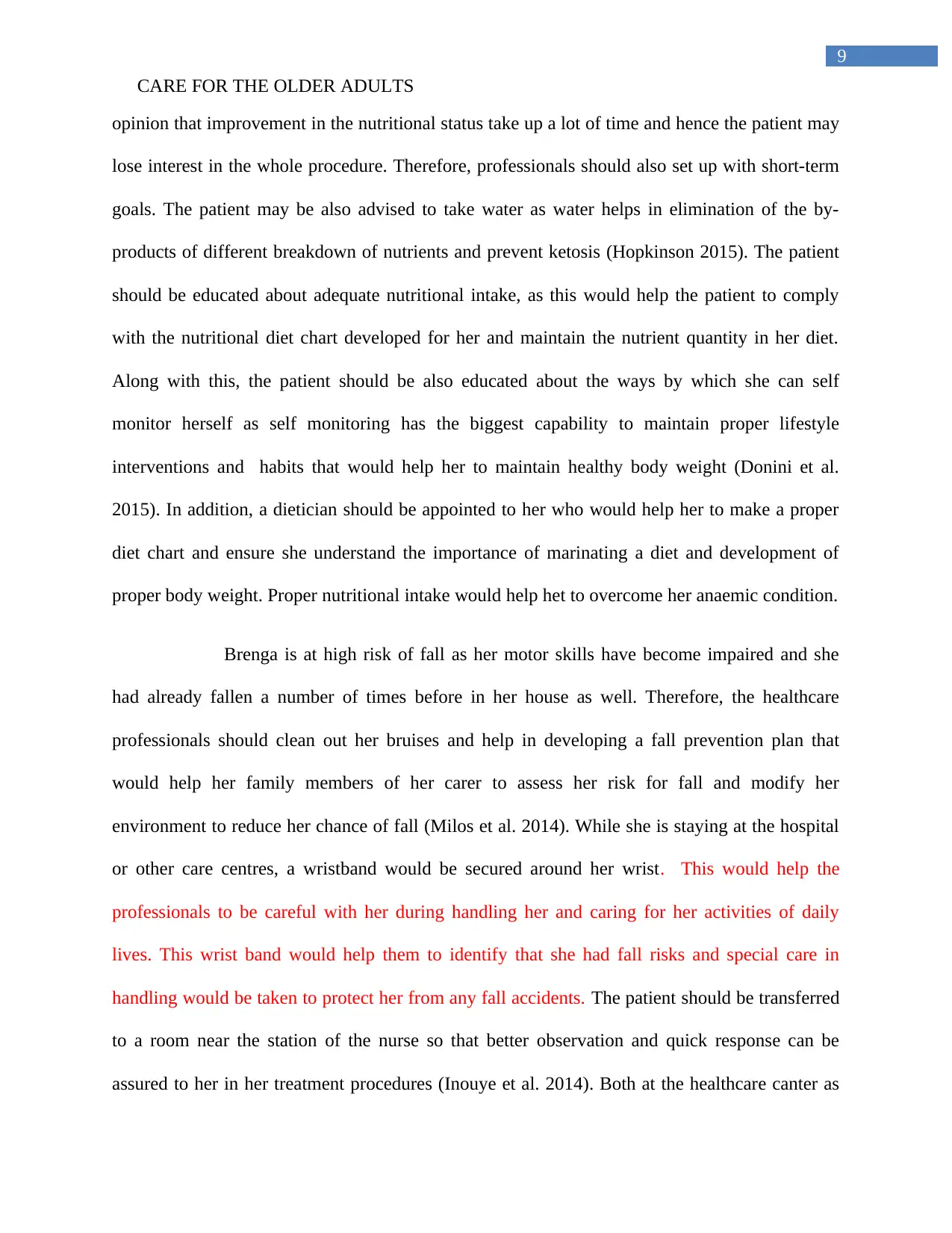
9
CARE FOR THE OLDER ADULTS
opinion that improvement in the nutritional status take up a lot of time and hence the patient may
lose interest in the whole procedure. Therefore, professionals should also set up with short-term
goals. The patient may be also advised to take water as water helps in elimination of the by-
products of different breakdown of nutrients and prevent ketosis (Hopkinson 2015). The patient
should be educated about adequate nutritional intake, as this would help the patient to comply
with the nutritional diet chart developed for her and maintain the nutrient quantity in her diet.
Along with this, the patient should be also educated about the ways by which she can self
monitor herself as self monitoring has the biggest capability to maintain proper lifestyle
interventions and habits that would help her to maintain healthy body weight (Donini et al.
2015). In addition, a dietician should be appointed to her who would help her to make a proper
diet chart and ensure she understand the importance of marinating a diet and development of
proper body weight. Proper nutritional intake would help het to overcome her anaemic condition.
Brenga is at high risk of fall as her motor skills have become impaired and she
had already fallen a number of times before in her house as well. Therefore, the healthcare
professionals should clean out her bruises and help in developing a fall prevention plan that
would help her family members of her carer to assess her risk for fall and modify her
environment to reduce her chance of fall (Milos et al. 2014). While she is staying at the hospital
or other care centres, a wristband would be secured around her wrist. This would help the
professionals to be careful with her during handling her and caring for her activities of daily
lives. This wrist band would help them to identify that she had fall risks and special care in
handling would be taken to protect her from any fall accidents. The patient should be transferred
to a room near the station of the nurse so that better observation and quick response can be
assured to her in her treatment procedures (Inouye et al. 2014). Both at the healthcare canter as
CARE FOR THE OLDER ADULTS
opinion that improvement in the nutritional status take up a lot of time and hence the patient may
lose interest in the whole procedure. Therefore, professionals should also set up with short-term
goals. The patient may be also advised to take water as water helps in elimination of the by-
products of different breakdown of nutrients and prevent ketosis (Hopkinson 2015). The patient
should be educated about adequate nutritional intake, as this would help the patient to comply
with the nutritional diet chart developed for her and maintain the nutrient quantity in her diet.
Along with this, the patient should be also educated about the ways by which she can self
monitor herself as self monitoring has the biggest capability to maintain proper lifestyle
interventions and habits that would help her to maintain healthy body weight (Donini et al.
2015). In addition, a dietician should be appointed to her who would help her to make a proper
diet chart and ensure she understand the importance of marinating a diet and development of
proper body weight. Proper nutritional intake would help het to overcome her anaemic condition.
Brenga is at high risk of fall as her motor skills have become impaired and she
had already fallen a number of times before in her house as well. Therefore, the healthcare
professionals should clean out her bruises and help in developing a fall prevention plan that
would help her family members of her carer to assess her risk for fall and modify her
environment to reduce her chance of fall (Milos et al. 2014). While she is staying at the hospital
or other care centres, a wristband would be secured around her wrist. This would help the
professionals to be careful with her during handling her and caring for her activities of daily
lives. This wrist band would help them to identify that she had fall risks and special care in
handling would be taken to protect her from any fall accidents. The patient should be transferred
to a room near the station of the nurse so that better observation and quick response can be
assured to her in her treatment procedures (Inouye et al. 2014). Both at the healthcare canter as
Secure Best Marks with AI Grader
Need help grading? Try our AI Grader for instant feedback on your assignments.
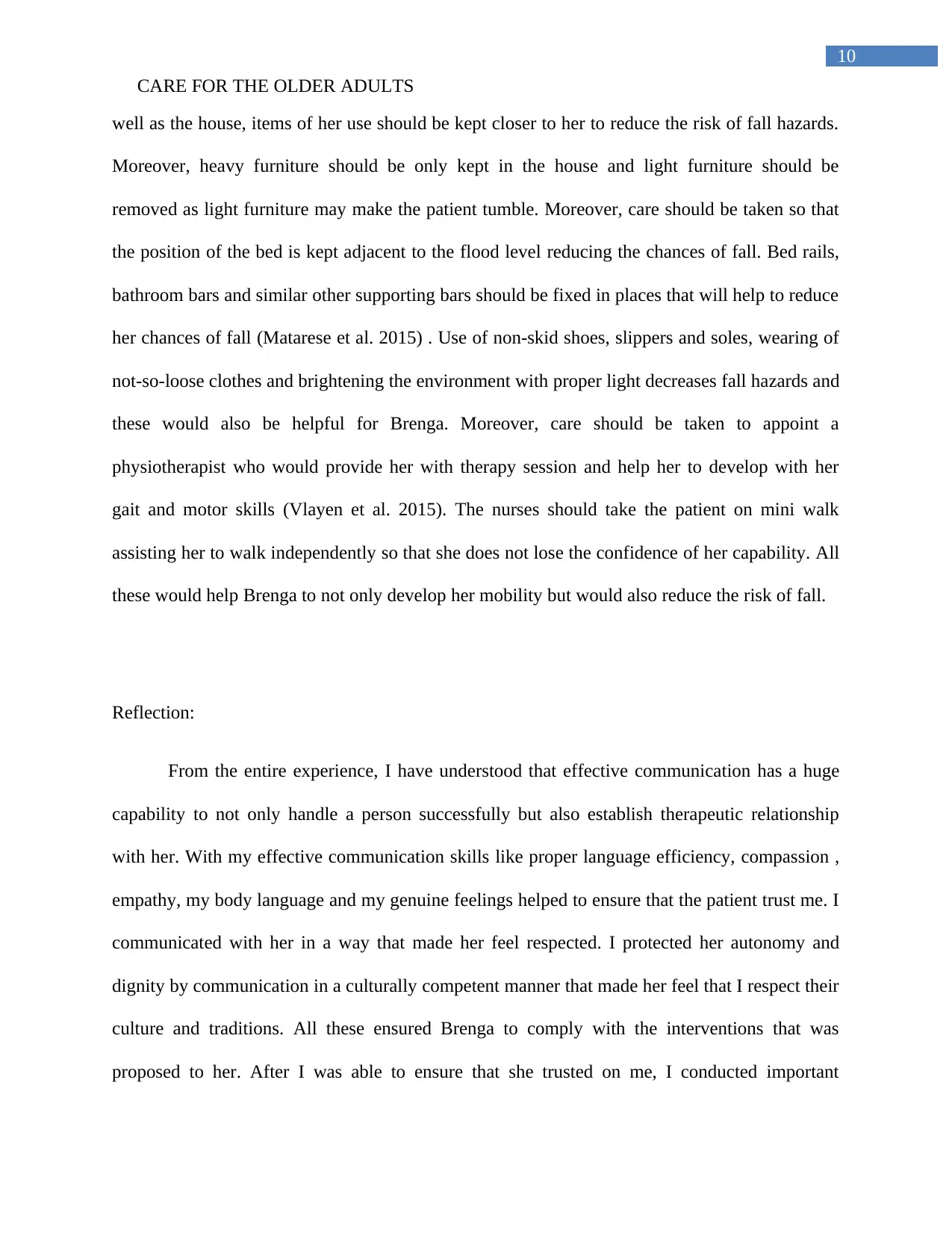
10
CARE FOR THE OLDER ADULTS
well as the house, items of her use should be kept closer to her to reduce the risk of fall hazards.
Moreover, heavy furniture should be only kept in the house and light furniture should be
removed as light furniture may make the patient tumble. Moreover, care should be taken so that
the position of the bed is kept adjacent to the flood level reducing the chances of fall. Bed rails,
bathroom bars and similar other supporting bars should be fixed in places that will help to reduce
her chances of fall (Matarese et al. 2015) . Use of non-skid shoes, slippers and soles, wearing of
not-so-loose clothes and brightening the environment with proper light decreases fall hazards and
these would also be helpful for Brenga. Moreover, care should be taken to appoint a
physiotherapist who would provide her with therapy session and help her to develop with her
gait and motor skills (Vlayen et al. 2015). The nurses should take the patient on mini walk
assisting her to walk independently so that she does not lose the confidence of her capability. All
these would help Brenga to not only develop her mobility but would also reduce the risk of fall.
Reflection:
From the entire experience, I have understood that effective communication has a huge
capability to not only handle a person successfully but also establish therapeutic relationship
with her. With my effective communication skills like proper language efficiency, compassion ,
empathy, my body language and my genuine feelings helped to ensure that the patient trust me. I
communicated with her in a way that made her feel respected. I protected her autonomy and
dignity by communication in a culturally competent manner that made her feel that I respect their
culture and traditions. All these ensured Brenga to comply with the interventions that was
proposed to her. After I was able to ensure that she trusted on me, I conducted important
CARE FOR THE OLDER ADULTS
well as the house, items of her use should be kept closer to her to reduce the risk of fall hazards.
Moreover, heavy furniture should be only kept in the house and light furniture should be
removed as light furniture may make the patient tumble. Moreover, care should be taken so that
the position of the bed is kept adjacent to the flood level reducing the chances of fall. Bed rails,
bathroom bars and similar other supporting bars should be fixed in places that will help to reduce
her chances of fall (Matarese et al. 2015) . Use of non-skid shoes, slippers and soles, wearing of
not-so-loose clothes and brightening the environment with proper light decreases fall hazards and
these would also be helpful for Brenga. Moreover, care should be taken to appoint a
physiotherapist who would provide her with therapy session and help her to develop with her
gait and motor skills (Vlayen et al. 2015). The nurses should take the patient on mini walk
assisting her to walk independently so that she does not lose the confidence of her capability. All
these would help Brenga to not only develop her mobility but would also reduce the risk of fall.
Reflection:
From the entire experience, I have understood that effective communication has a huge
capability to not only handle a person successfully but also establish therapeutic relationship
with her. With my effective communication skills like proper language efficiency, compassion ,
empathy, my body language and my genuine feelings helped to ensure that the patient trust me. I
communicated with her in a way that made her feel respected. I protected her autonomy and
dignity by communication in a culturally competent manner that made her feel that I respect their
culture and traditions. All these ensured Brenga to comply with the interventions that was
proposed to her. After I was able to ensure that she trusted on me, I conducted important
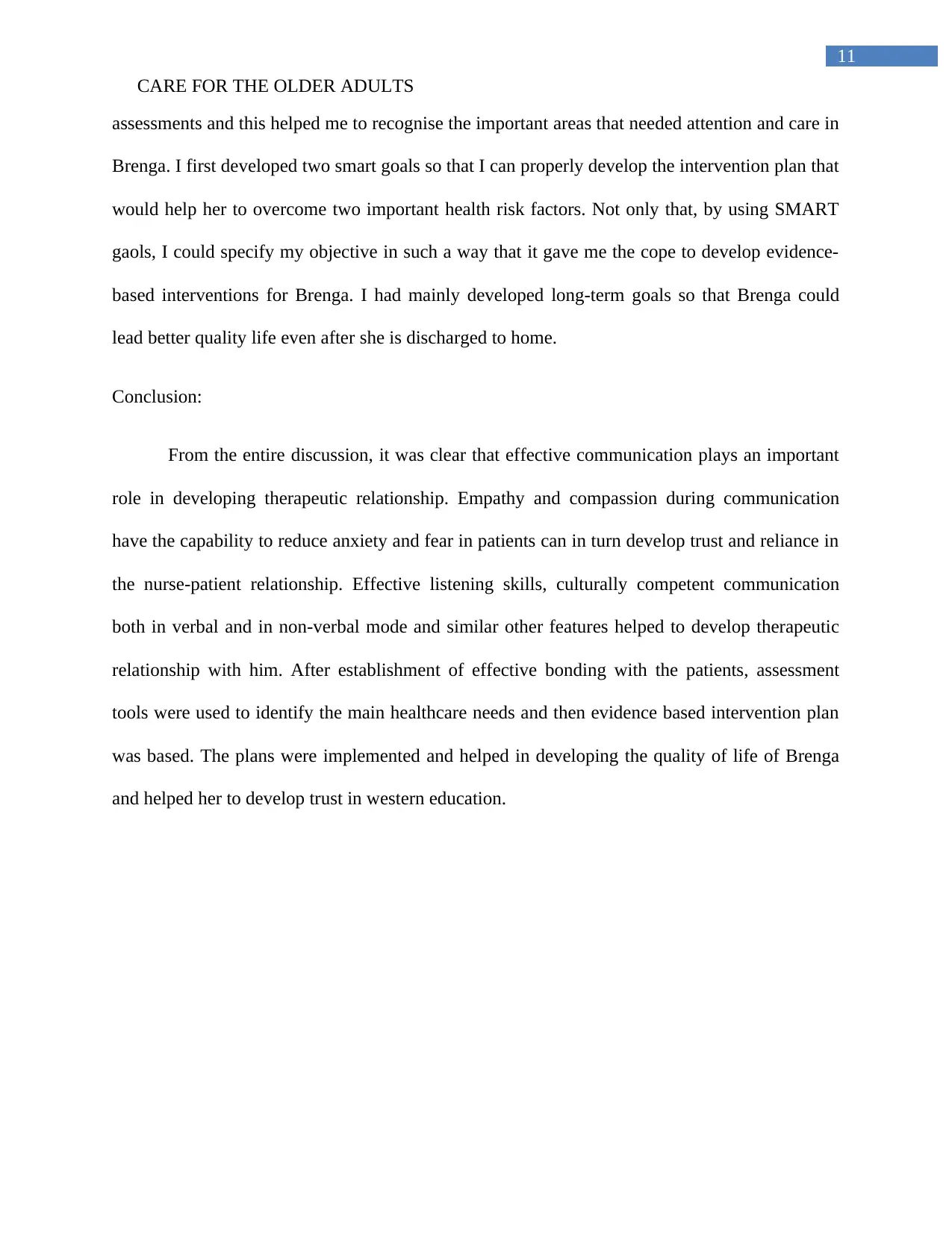
11
CARE FOR THE OLDER ADULTS
assessments and this helped me to recognise the important areas that needed attention and care in
Brenga. I first developed two smart goals so that I can properly develop the intervention plan that
would help her to overcome two important health risk factors. Not only that, by using SMART
gaols, I could specify my objective in such a way that it gave me the cope to develop evidence-
based interventions for Brenga. I had mainly developed long-term goals so that Brenga could
lead better quality life even after she is discharged to home.
Conclusion:
From the entire discussion, it was clear that effective communication plays an important
role in developing therapeutic relationship. Empathy and compassion during communication
have the capability to reduce anxiety and fear in patients can in turn develop trust and reliance in
the nurse-patient relationship. Effective listening skills, culturally competent communication
both in verbal and in non-verbal mode and similar other features helped to develop therapeutic
relationship with him. After establishment of effective bonding with the patients, assessment
tools were used to identify the main healthcare needs and then evidence based intervention plan
was based. The plans were implemented and helped in developing the quality of life of Brenga
and helped her to develop trust in western education.
CARE FOR THE OLDER ADULTS
assessments and this helped me to recognise the important areas that needed attention and care in
Brenga. I first developed two smart goals so that I can properly develop the intervention plan that
would help her to overcome two important health risk factors. Not only that, by using SMART
gaols, I could specify my objective in such a way that it gave me the cope to develop evidence-
based interventions for Brenga. I had mainly developed long-term goals so that Brenga could
lead better quality life even after she is discharged to home.
Conclusion:
From the entire discussion, it was clear that effective communication plays an important
role in developing therapeutic relationship. Empathy and compassion during communication
have the capability to reduce anxiety and fear in patients can in turn develop trust and reliance in
the nurse-patient relationship. Effective listening skills, culturally competent communication
both in verbal and in non-verbal mode and similar other features helped to develop therapeutic
relationship with him. After establishment of effective bonding with the patients, assessment
tools were used to identify the main healthcare needs and then evidence based intervention plan
was based. The plans were implemented and helped in developing the quality of life of Brenga
and helped her to develop trust in western education.
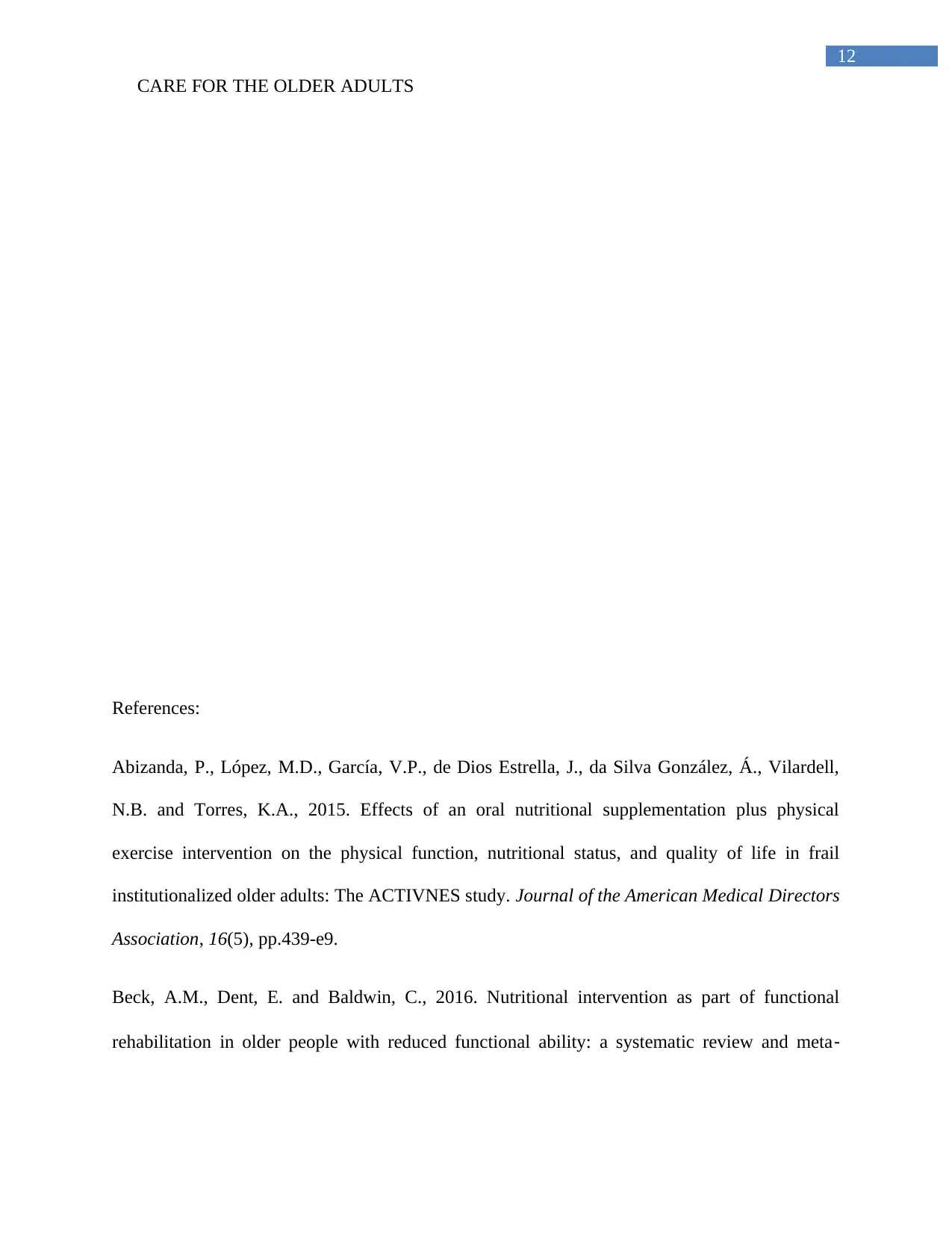
12
CARE FOR THE OLDER ADULTS
References:
Abizanda, P., López, M.D., García, V.P., de Dios Estrella, J., da Silva González, Á., Vilardell,
N.B. and Torres, K.A., 2015. Effects of an oral nutritional supplementation plus physical
exercise intervention on the physical function, nutritional status, and quality of life in frail
institutionalized older adults: The ACTIVNES study. Journal of the American Medical Directors
Association, 16(5), pp.439-e9.
Beck, A.M., Dent, E. and Baldwin, C., 2016. Nutritional intervention as part of functional
rehabilitation in older people with reduced functional ability: a systematic review and meta‐
CARE FOR THE OLDER ADULTS
References:
Abizanda, P., López, M.D., García, V.P., de Dios Estrella, J., da Silva González, Á., Vilardell,
N.B. and Torres, K.A., 2015. Effects of an oral nutritional supplementation plus physical
exercise intervention on the physical function, nutritional status, and quality of life in frail
institutionalized older adults: The ACTIVNES study. Journal of the American Medical Directors
Association, 16(5), pp.439-e9.
Beck, A.M., Dent, E. and Baldwin, C., 2016. Nutritional intervention as part of functional
rehabilitation in older people with reduced functional ability: a systematic review and meta‐
Paraphrase This Document
Need a fresh take? Get an instant paraphrase of this document with our AI Paraphraser
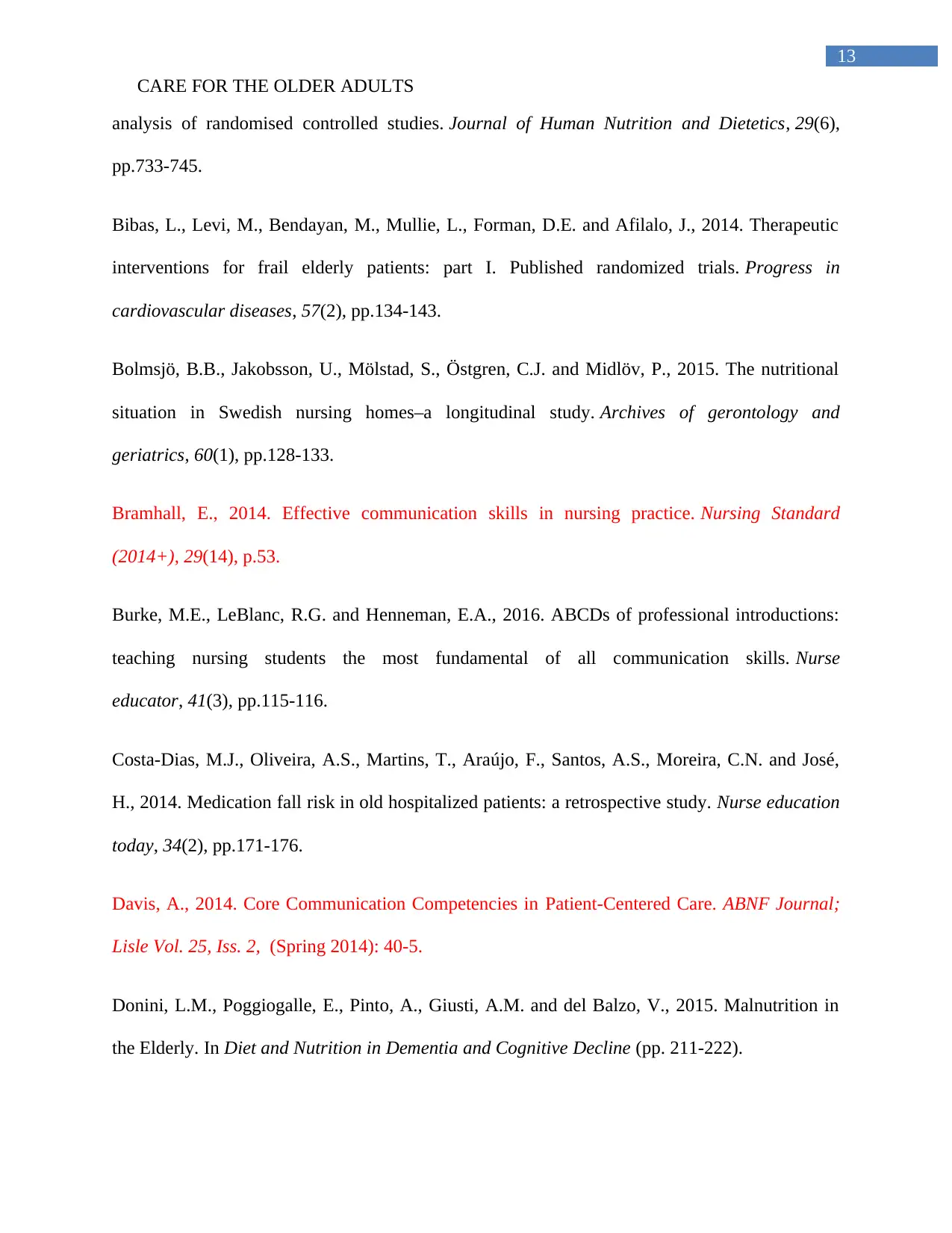
13
CARE FOR THE OLDER ADULTS
analysis of randomised controlled studies. Journal of Human Nutrition and Dietetics, 29(6),
pp.733-745.
Bibas, L., Levi, M., Bendayan, M., Mullie, L., Forman, D.E. and Afilalo, J., 2014. Therapeutic
interventions for frail elderly patients: part I. Published randomized trials. Progress in
cardiovascular diseases, 57(2), pp.134-143.
Bolmsjö, B.B., Jakobsson, U., Mölstad, S., Östgren, C.J. and Midlöv, P., 2015. The nutritional
situation in Swedish nursing homes–a longitudinal study. Archives of gerontology and
geriatrics, 60(1), pp.128-133.
Bramhall, E., 2014. Effective communication skills in nursing practice. Nursing Standard
(2014+), 29(14), p.53.
Burke, M.E., LeBlanc, R.G. and Henneman, E.A., 2016. ABCDs of professional introductions:
teaching nursing students the most fundamental of all communication skills. Nurse
educator, 41(3), pp.115-116.
Costa-Dias, M.J., Oliveira, A.S., Martins, T., Araújo, F., Santos, A.S., Moreira, C.N. and José,
H., 2014. Medication fall risk in old hospitalized patients: a retrospective study. Nurse education
today, 34(2), pp.171-176.
Davis, A., 2014. Core Communication Competencies in Patient-Centered Care. ABNF Journal;
Lisle Vol. 25, Iss. 2, (Spring 2014): 40-5.
Donini, L.M., Poggiogalle, E., Pinto, A., Giusti, A.M. and del Balzo, V., 2015. Malnutrition in
the Elderly. In Diet and Nutrition in Dementia and Cognitive Decline (pp. 211-222).
CARE FOR THE OLDER ADULTS
analysis of randomised controlled studies. Journal of Human Nutrition and Dietetics, 29(6),
pp.733-745.
Bibas, L., Levi, M., Bendayan, M., Mullie, L., Forman, D.E. and Afilalo, J., 2014. Therapeutic
interventions for frail elderly patients: part I. Published randomized trials. Progress in
cardiovascular diseases, 57(2), pp.134-143.
Bolmsjö, B.B., Jakobsson, U., Mölstad, S., Östgren, C.J. and Midlöv, P., 2015. The nutritional
situation in Swedish nursing homes–a longitudinal study. Archives of gerontology and
geriatrics, 60(1), pp.128-133.
Bramhall, E., 2014. Effective communication skills in nursing practice. Nursing Standard
(2014+), 29(14), p.53.
Burke, M.E., LeBlanc, R.G. and Henneman, E.A., 2016. ABCDs of professional introductions:
teaching nursing students the most fundamental of all communication skills. Nurse
educator, 41(3), pp.115-116.
Costa-Dias, M.J., Oliveira, A.S., Martins, T., Araújo, F., Santos, A.S., Moreira, C.N. and José,
H., 2014. Medication fall risk in old hospitalized patients: a retrospective study. Nurse education
today, 34(2), pp.171-176.
Davis, A., 2014. Core Communication Competencies in Patient-Centered Care. ABNF Journal;
Lisle Vol. 25, Iss. 2, (Spring 2014): 40-5.
Donini, L.M., Poggiogalle, E., Pinto, A., Giusti, A.M. and del Balzo, V., 2015. Malnutrition in
the Elderly. In Diet and Nutrition in Dementia and Cognitive Decline (pp. 211-222).
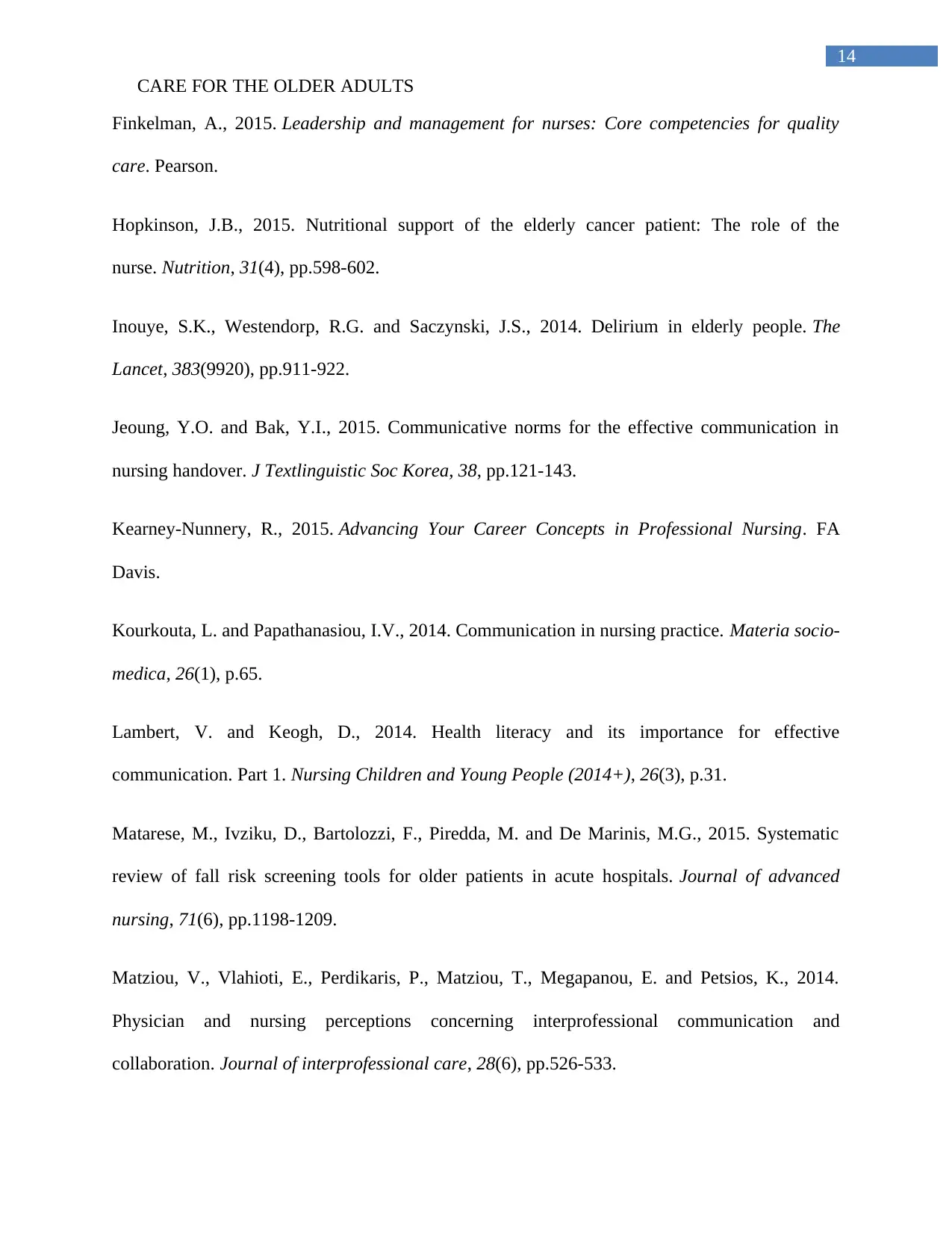
14
CARE FOR THE OLDER ADULTS
Finkelman, A., 2015. Leadership and management for nurses: Core competencies for quality
care. Pearson.
Hopkinson, J.B., 2015. Nutritional support of the elderly cancer patient: The role of the
nurse. Nutrition, 31(4), pp.598-602.
Inouye, S.K., Westendorp, R.G. and Saczynski, J.S., 2014. Delirium in elderly people. The
Lancet, 383(9920), pp.911-922.
Jeoung, Y.O. and Bak, Y.I., 2015. Communicative norms for the effective communication in
nursing handover. J Textlinguistic Soc Korea, 38, pp.121-143.
Kearney-Nunnery, R., 2015. Advancing Your Career Concepts in Professional Nursing. FA
Davis.
Kourkouta, L. and Papathanasiou, I.V., 2014. Communication in nursing practice. Materia socio-
medica, 26(1), p.65.
Lambert, V. and Keogh, D., 2014. Health literacy and its importance for effective
communication. Part 1. Nursing Children and Young People (2014+), 26(3), p.31.
Matarese, M., Ivziku, D., Bartolozzi, F., Piredda, M. and De Marinis, M.G., 2015. Systematic
review of fall risk screening tools for older patients in acute hospitals. Journal of advanced
nursing, 71(6), pp.1198-1209.
Matziou, V., Vlahioti, E., Perdikaris, P., Matziou, T., Megapanou, E. and Petsios, K., 2014.
Physician and nursing perceptions concerning interprofessional communication and
collaboration. Journal of interprofessional care, 28(6), pp.526-533.
CARE FOR THE OLDER ADULTS
Finkelman, A., 2015. Leadership and management for nurses: Core competencies for quality
care. Pearson.
Hopkinson, J.B., 2015. Nutritional support of the elderly cancer patient: The role of the
nurse. Nutrition, 31(4), pp.598-602.
Inouye, S.K., Westendorp, R.G. and Saczynski, J.S., 2014. Delirium in elderly people. The
Lancet, 383(9920), pp.911-922.
Jeoung, Y.O. and Bak, Y.I., 2015. Communicative norms for the effective communication in
nursing handover. J Textlinguistic Soc Korea, 38, pp.121-143.
Kearney-Nunnery, R., 2015. Advancing Your Career Concepts in Professional Nursing. FA
Davis.
Kourkouta, L. and Papathanasiou, I.V., 2014. Communication in nursing practice. Materia socio-
medica, 26(1), p.65.
Lambert, V. and Keogh, D., 2014. Health literacy and its importance for effective
communication. Part 1. Nursing Children and Young People (2014+), 26(3), p.31.
Matarese, M., Ivziku, D., Bartolozzi, F., Piredda, M. and De Marinis, M.G., 2015. Systematic
review of fall risk screening tools for older patients in acute hospitals. Journal of advanced
nursing, 71(6), pp.1198-1209.
Matziou, V., Vlahioti, E., Perdikaris, P., Matziou, T., Megapanou, E. and Petsios, K., 2014.
Physician and nursing perceptions concerning interprofessional communication and
collaboration. Journal of interprofessional care, 28(6), pp.526-533.
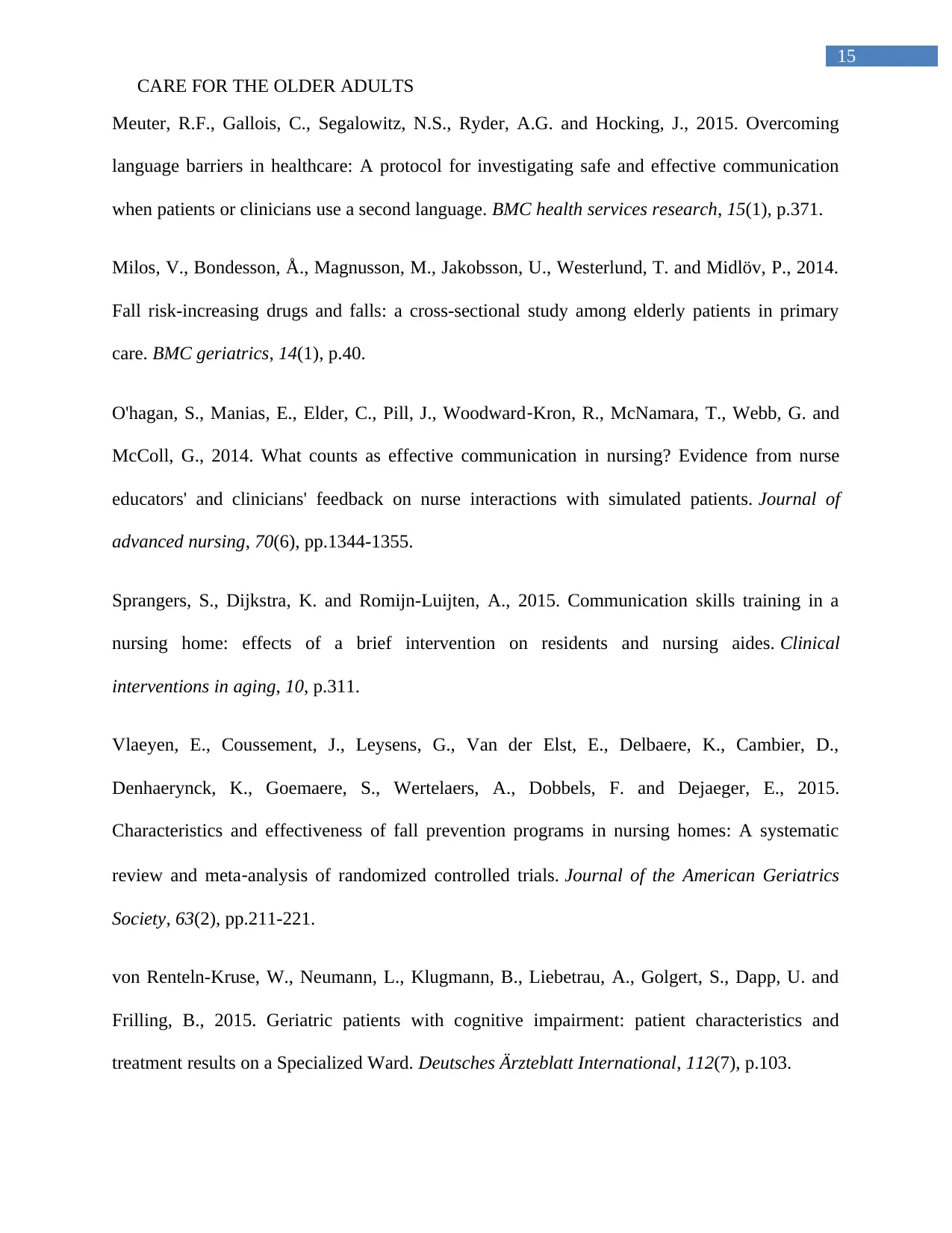
15
CARE FOR THE OLDER ADULTS
Meuter, R.F., Gallois, C., Segalowitz, N.S., Ryder, A.G. and Hocking, J., 2015. Overcoming
language barriers in healthcare: A protocol for investigating safe and effective communication
when patients or clinicians use a second language. BMC health services research, 15(1), p.371.
Milos, V., Bondesson, Å., Magnusson, M., Jakobsson, U., Westerlund, T. and Midlöv, P., 2014.
Fall risk-increasing drugs and falls: a cross-sectional study among elderly patients in primary
care. BMC geriatrics, 14(1), p.40.
O'hagan, S., Manias, E., Elder, C., Pill, J., Woodward‐Kron, R., McNamara, T., Webb, G. and
McColl, G., 2014. What counts as effective communication in nursing? Evidence from nurse
educators' and clinicians' feedback on nurse interactions with simulated patients. Journal of
advanced nursing, 70(6), pp.1344-1355.
Sprangers, S., Dijkstra, K. and Romijn-Luijten, A., 2015. Communication skills training in a
nursing home: effects of a brief intervention on residents and nursing aides. Clinical
interventions in aging, 10, p.311.
Vlaeyen, E., Coussement, J., Leysens, G., Van der Elst, E., Delbaere, K., Cambier, D.,
Denhaerynck, K., Goemaere, S., Wertelaers, A., Dobbels, F. and Dejaeger, E., 2015.
Characteristics and effectiveness of fall prevention programs in nursing homes: A systematic
review and meta‐analysis of randomized controlled trials. Journal of the American Geriatrics
Society, 63(2), pp.211-221.
von Renteln-Kruse, W., Neumann, L., Klugmann, B., Liebetrau, A., Golgert, S., Dapp, U. and
Frilling, B., 2015. Geriatric patients with cognitive impairment: patient characteristics and
treatment results on a Specialized Ward. Deutsches Ärzteblatt International, 112(7), p.103.
CARE FOR THE OLDER ADULTS
Meuter, R.F., Gallois, C., Segalowitz, N.S., Ryder, A.G. and Hocking, J., 2015. Overcoming
language barriers in healthcare: A protocol for investigating safe and effective communication
when patients or clinicians use a second language. BMC health services research, 15(1), p.371.
Milos, V., Bondesson, Å., Magnusson, M., Jakobsson, U., Westerlund, T. and Midlöv, P., 2014.
Fall risk-increasing drugs and falls: a cross-sectional study among elderly patients in primary
care. BMC geriatrics, 14(1), p.40.
O'hagan, S., Manias, E., Elder, C., Pill, J., Woodward‐Kron, R., McNamara, T., Webb, G. and
McColl, G., 2014. What counts as effective communication in nursing? Evidence from nurse
educators' and clinicians' feedback on nurse interactions with simulated patients. Journal of
advanced nursing, 70(6), pp.1344-1355.
Sprangers, S., Dijkstra, K. and Romijn-Luijten, A., 2015. Communication skills training in a
nursing home: effects of a brief intervention on residents and nursing aides. Clinical
interventions in aging, 10, p.311.
Vlaeyen, E., Coussement, J., Leysens, G., Van der Elst, E., Delbaere, K., Cambier, D.,
Denhaerynck, K., Goemaere, S., Wertelaers, A., Dobbels, F. and Dejaeger, E., 2015.
Characteristics and effectiveness of fall prevention programs in nursing homes: A systematic
review and meta‐analysis of randomized controlled trials. Journal of the American Geriatrics
Society, 63(2), pp.211-221.
von Renteln-Kruse, W., Neumann, L., Klugmann, B., Liebetrau, A., Golgert, S., Dapp, U. and
Frilling, B., 2015. Geriatric patients with cognitive impairment: patient characteristics and
treatment results on a Specialized Ward. Deutsches Ärzteblatt International, 112(7), p.103.
Secure Best Marks with AI Grader
Need help grading? Try our AI Grader for instant feedback on your assignments.
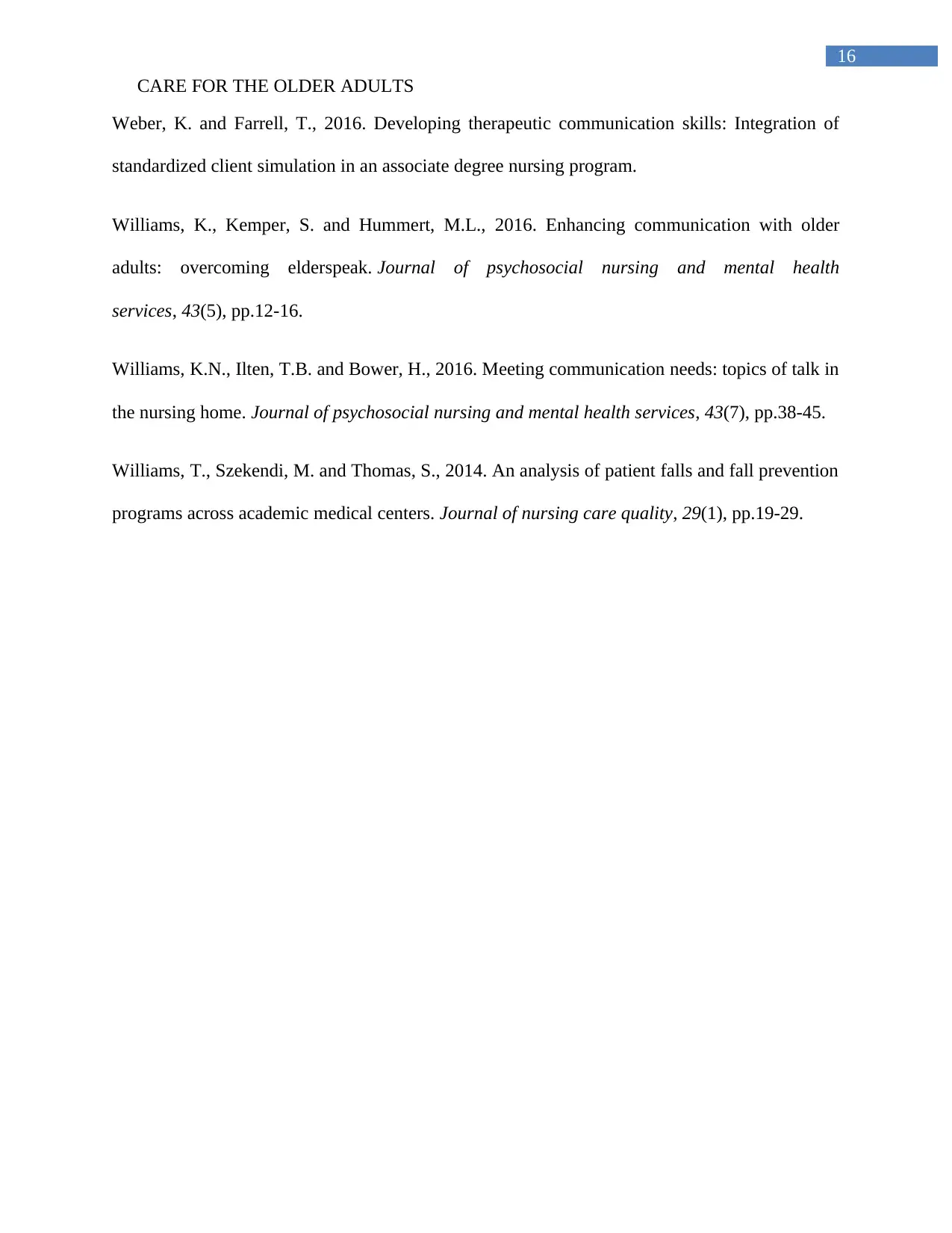
16
CARE FOR THE OLDER ADULTS
Weber, K. and Farrell, T., 2016. Developing therapeutic communication skills: Integration of
standardized client simulation in an associate degree nursing program.
Williams, K., Kemper, S. and Hummert, M.L., 2016. Enhancing communication with older
adults: overcoming elderspeak. Journal of psychosocial nursing and mental health
services, 43(5), pp.12-16.
Williams, K.N., Ilten, T.B. and Bower, H., 2016. Meeting communication needs: topics of talk in
the nursing home. Journal of psychosocial nursing and mental health services, 43(7), pp.38-45.
Williams, T., Szekendi, M. and Thomas, S., 2014. An analysis of patient falls and fall prevention
programs across academic medical centers. Journal of nursing care quality, 29(1), pp.19-29.
CARE FOR THE OLDER ADULTS
Weber, K. and Farrell, T., 2016. Developing therapeutic communication skills: Integration of
standardized client simulation in an associate degree nursing program.
Williams, K., Kemper, S. and Hummert, M.L., 2016. Enhancing communication with older
adults: overcoming elderspeak. Journal of psychosocial nursing and mental health
services, 43(5), pp.12-16.
Williams, K.N., Ilten, T.B. and Bower, H., 2016. Meeting communication needs: topics of talk in
the nursing home. Journal of psychosocial nursing and mental health services, 43(7), pp.38-45.
Williams, T., Szekendi, M. and Thomas, S., 2014. An analysis of patient falls and fall prevention
programs across academic medical centers. Journal of nursing care quality, 29(1), pp.19-29.
1 out of 17
Related Documents
Your All-in-One AI-Powered Toolkit for Academic Success.
+13062052269
info@desklib.com
Available 24*7 on WhatsApp / Email
![[object Object]](/_next/static/media/star-bottom.7253800d.svg)
Unlock your academic potential
© 2024 | Zucol Services PVT LTD | All rights reserved.





